PRIMAVERA IN VIAGGIO IN ITALIA – Springtime on the road in Italy
With the relaxing of travel restrictions, we celebrated a wedding anniversary and Spring, on the road.
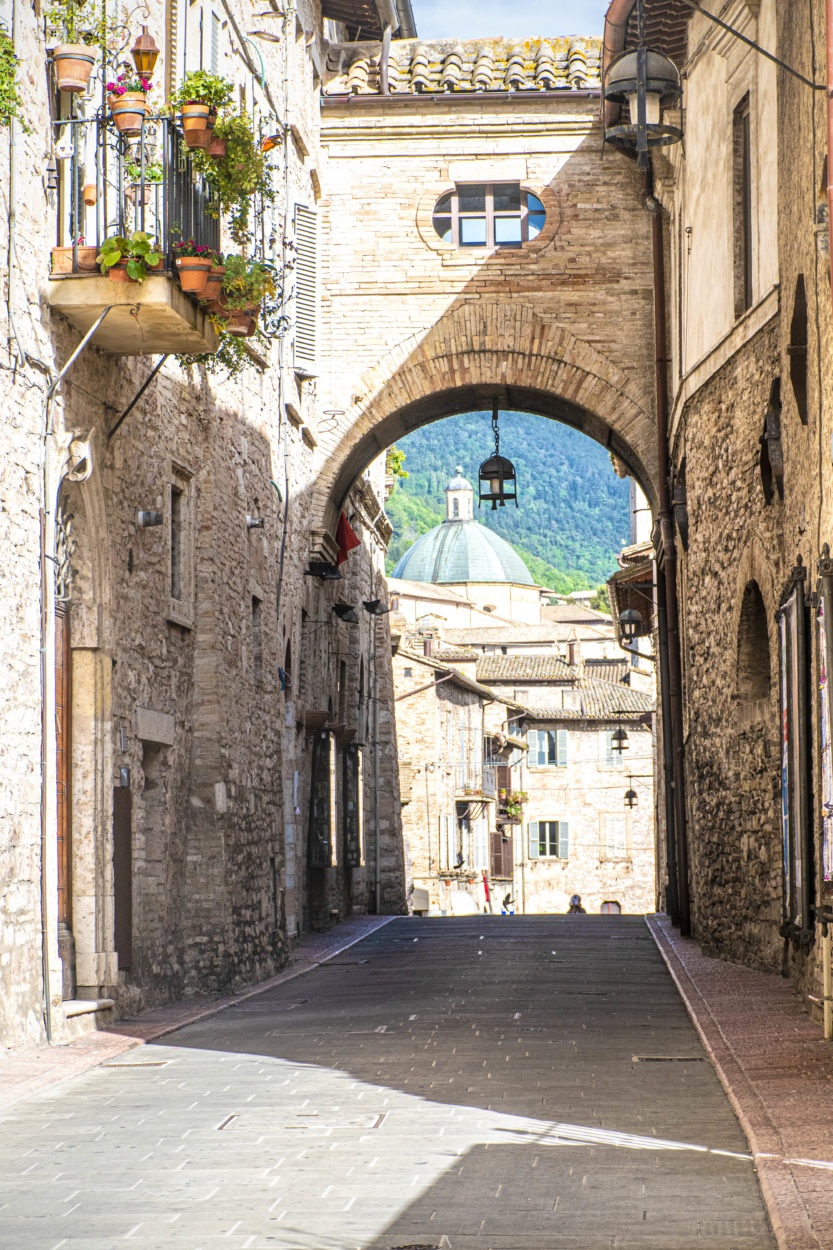
Assisi. Upper town with the dome of San Rufino in the background.
There seems to be something perverse in human nature when told you cannot do something – it only increases your desire to do it. The impact of the COVID-19 viral epidemic on all our lives has been beyond anything we could have imagined. Considering the depth of tragedy this malady has brought into so many lives, it seems inappropriate to have been so discontented with lockdowns, social distancing, and the cancelling of stimulating experiences that serve to broaden life. But we confess, as gratified as we are to be living in this exceptional provincial Italian town, having our movements restricted seems to have only sharpened our appetite to travel and expand our experiences of Italy. But, we finally got an opening.
We have been enjoying the expansive benefit of immersion into the daily life of a culture different from the one in which we were nurtured, by actually living in this community of others. A significant additional benefit in living here is the increased range and ease of our travel possibilities. Now, we can plan any number of shorter, focused, exploratory excursions, to experience places not generally accessible on a whirlwind itinerary. All in the same time zone we are already acclimated to.
What previously required a grueling full day of travel and left us exhausted to reach exciting places, is now just a pleasant several hour drive through the beautiful Italian countryside. Added to that, we can choose the timing to optimize the uniqueness of the seasons and the greatest benefit of all, to be able to avoid the crowds inherent in mass tourism.
Nonessential movement restrictions between Italian Regions had only recently been lifted. In fact, not long ago, nonessential travel outside our local community could result in a monetary fine. Last Fall, we had changed our around town car for something more suited to travelling on the road. We initially took advantage of that new resource and made a trip to the south of Italy. That experience only whetted our appetite for more.
Then the travel restrictions fell into place. We had already begun serious consideration to see more of the nearby Region of Umbria. We had been in Umbria many years ago but had never gotten to Assisi. The restrictions on travel caused the plans to see Assisi to be postponed. With the lifting of restrictions, we resurrected them.
As it turns out, the 21st of May is our wedding anniversary. That calendar event became the focal point around which our travel plans revolved. We set our sights on Assisi as our first goal and decided to avoid a weekend with the inevitable religious services involving religious sites being closed to viewing.
We then decided to make the most of the opportunity by coming back to Ascoli by a different route. We settled on Orvieto as our second travel goal. Unlike Assisi which we had not previously visited, we had been to Orvieto but that had been over thirteen years earlier, with an all too brief visit, and it seemed like time for a revisit. So, we did.
Our partnership involves a mutually evolved division of travel responsibilities, with requisite coordination of course. I seem to handle travel routing. Arlene excels in a capacity to locate optimum accommodations and gastronomic options. We both have a common affinity on what we want to experience. Over the years, we consult Rick Steve’s where his advice is accessible but even then, we make our own adjustments as to priorities. augmented by the feedback we share between our friends.
Assisi is very much an Italian hill town. The complex by which Assisi is perhaps best known, the Basilica of Saint Francis, is in the lower, northwestern area of the town. In the upper, southeastern portion of Assisi are other notable sites. A little higher still is the Piazza Matteotti, with a major parking complex. Our hotel, the Ideale, was in this area with their own parking area on their site. Arlene was able to secure for us a top floor room with a balcony overlooking Assisi.
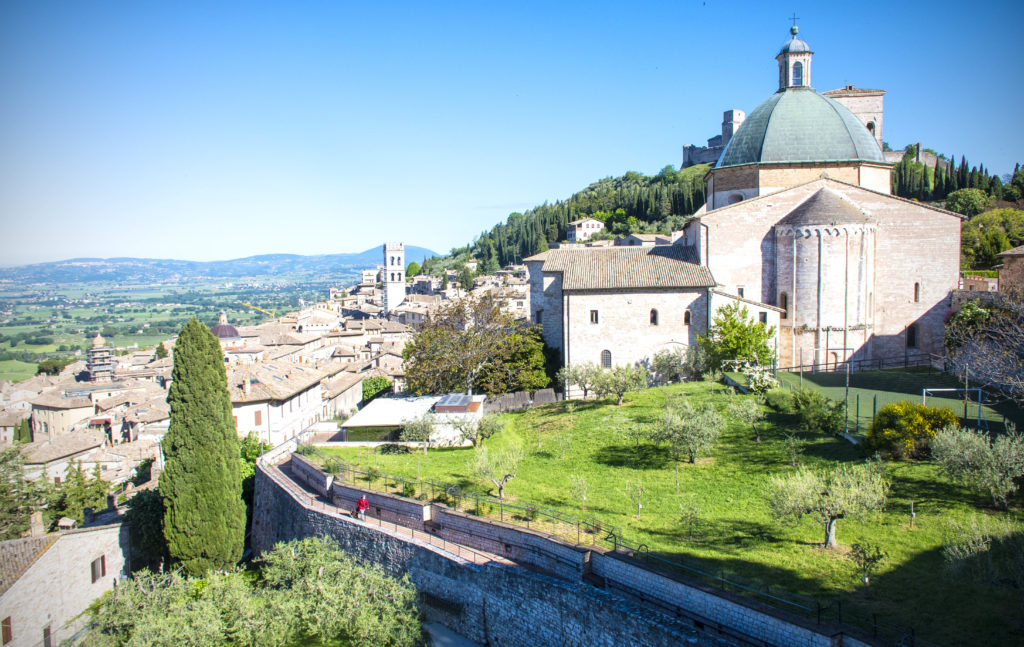
Assisi from our balcony. The dome and rear of the Cathedral of San Rufino is in the foreground and the bell tower of the Basilica of Saint Francis is in the distance.
Saint Francis of Assisi
From time-to-time, voices emerge from within organizations seeking to redeem institutions from what appear to be deviations from their stated original purpose. One such figure was the seemingly unlikely Francesco Bernardone, born into a prominent Assisi family in 1181.
In 1202, fulfilling his expected role as a young man of a consequential family, he joined a military campaign against a rival city-state of Assisi that resulted in his being captured and imprisoned. On his release, he returned home having been changed by his experiences and renounced his former life. He became a man deeply searching for answers. In 1206, he reportedly had a spiritual vision that changed his life. He became devoted to God and renounced a life of material privilege. Taking holy orders, he felt compelled to follow the inspiration he found in the reported life and words of Jesus to care for the poor and sick. He came to see wealth and privilege as an obstacle to a true religious calling.
The Roman Empire had earlier fallen, succumbing to successive attacking waves of Germanic tribes coming south. Historians largely agree, the once powerful Roman Empire became weakened over time as a result of rampant corruption, financial strain due to over extended military expenditures and endless political infighting. In a weakened condition, Rome was no longer capable of defending itself.
Many of the invading tribes from the north were polytheistic, but during the period of the expanded Roman Empire in its later stages, some of these Germanic people had become exposed to an early form of Christianity. Fertile Italy was a sought after prize for the conquers from the north, and they stayed. The adoption of Christianity by some of the dominant Germanic tribes brought in a feudal socio-political structure organized around areas administered by a feudal Lord in concert with Bishops of the evolving Christian Church.
It was a socio-political structure that provided some amount of coherence to society in what has been referred to as the ‘Dark Ages’ following the collapse of the Roman Empire. As the Christian Church grew, religious administrative territories were further divided into new dioceses each with their own Bishop. Assisi became its own diocese in the 11th century.
By the early Middle Ages, the power of feudal Lords and the Bishops of the Christian Church, at their right elbow, had become dominant. It was a common practice of feudal Lords and Bishops to project their power, wealth, and influence by the opulence of the Christian religious structures they had erected within their territories. Many significant religious edifices dating from the Middle Ages in Europe owe their existence to this practice.
The conflation of opulence, with the level of intrigue necessary to sustain political power, had a predictable effect on the Christian Church of the time, causing it to devote less attention and resources on the poor and needy with an attendant rise in levels of corruption. It was against this background that the young Monk, Friar Francis, set himself the task of turning against that tide to live a life of poverty and obedience to God, rather than political power underwritten by wealth. As awareness of his deeds and preaching began to spread, others of like mind asked to join him. In due course, the Rules for the Franciscan Monastic Order were approved by Pope Innocent the Third.
The Basilica of Saint Francis of Assisi is recognized as a masterpiece of religious art that includes works by some of the most highly acclaimed names in the early history of Italian Renaissance painting such as Cimabue and Gotto. Art historians in that period, such as Vasari, credit both Cimabue and Giotto as being notable in breaking away from a previous approach to painting that had reflected Greek Iconographic influence in favor of a more naturalistic style. Artistic depictions were underwritten by the early church as a means to spread the Gospel in a pre-literate society. A more naturalistic form of depictions of religious themes became more popular as more potentially accessible to motivate the masses than previous, less relatable pictorial styles.
The desire to pay homage to the life of St. Francis resulted in his canonization as a saint not long after his death. Given the highly decorative form this basilica has taken, with its rich artistic embellishments, it is unclear what the self effacing Friar Francis would have thought about it.
It is also notable the current Pope took the name of Francis in 2013 as an expression of his dedication to promote Christian charity to the benefit of the poor and needy. Pope Francis has spoken out forcefully at what he views as an overly materialistic, contemporary society. As in the days of Saint Francis, the institution of the temporal Christian church has not always been in complete accord with redirection back to its original principals. At each stage of the evolution of Christianity, temporal preoccupations have not always merged well with the original intent of the faith.
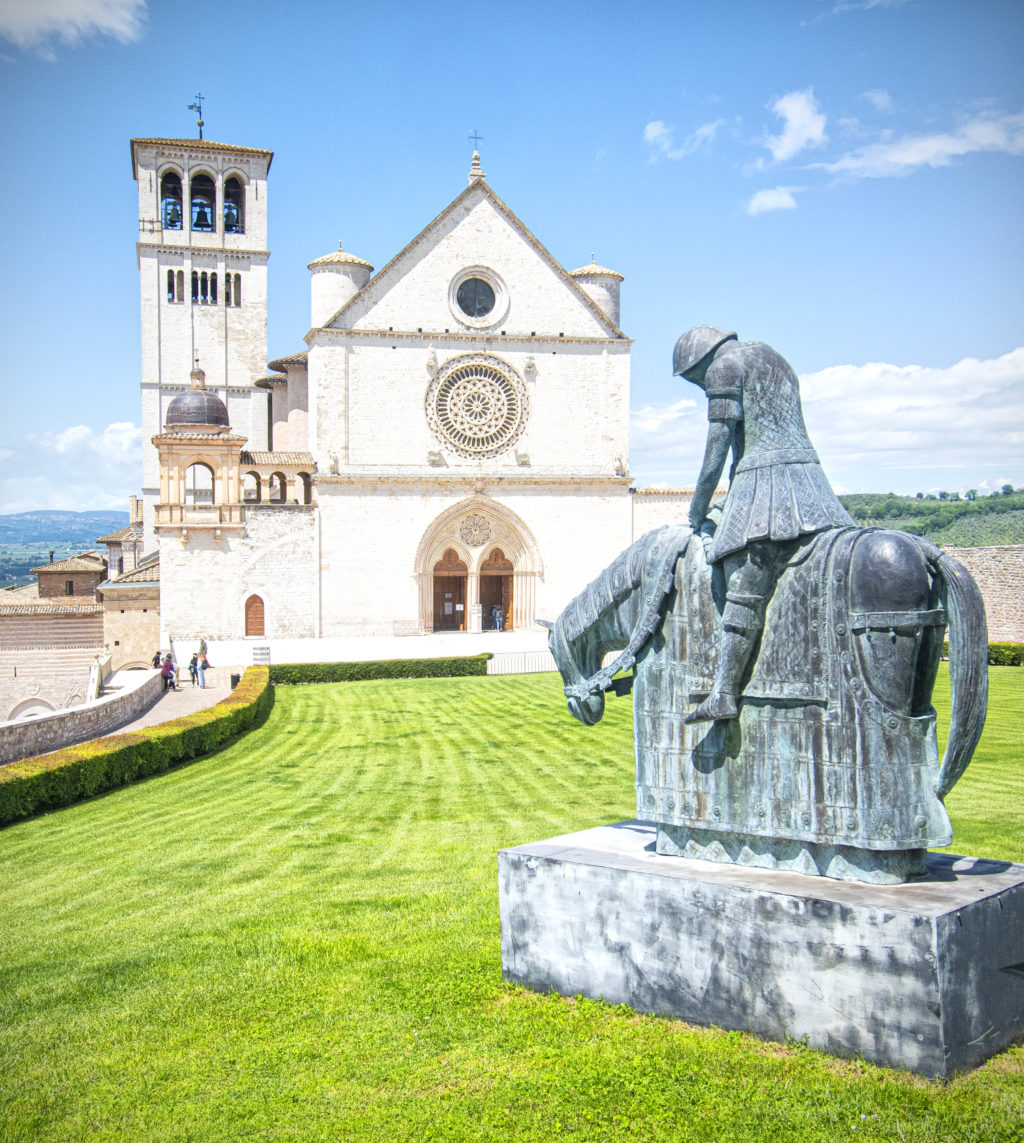
Assisi. The Basilica of Saint Francis in the Italian Gothic style.
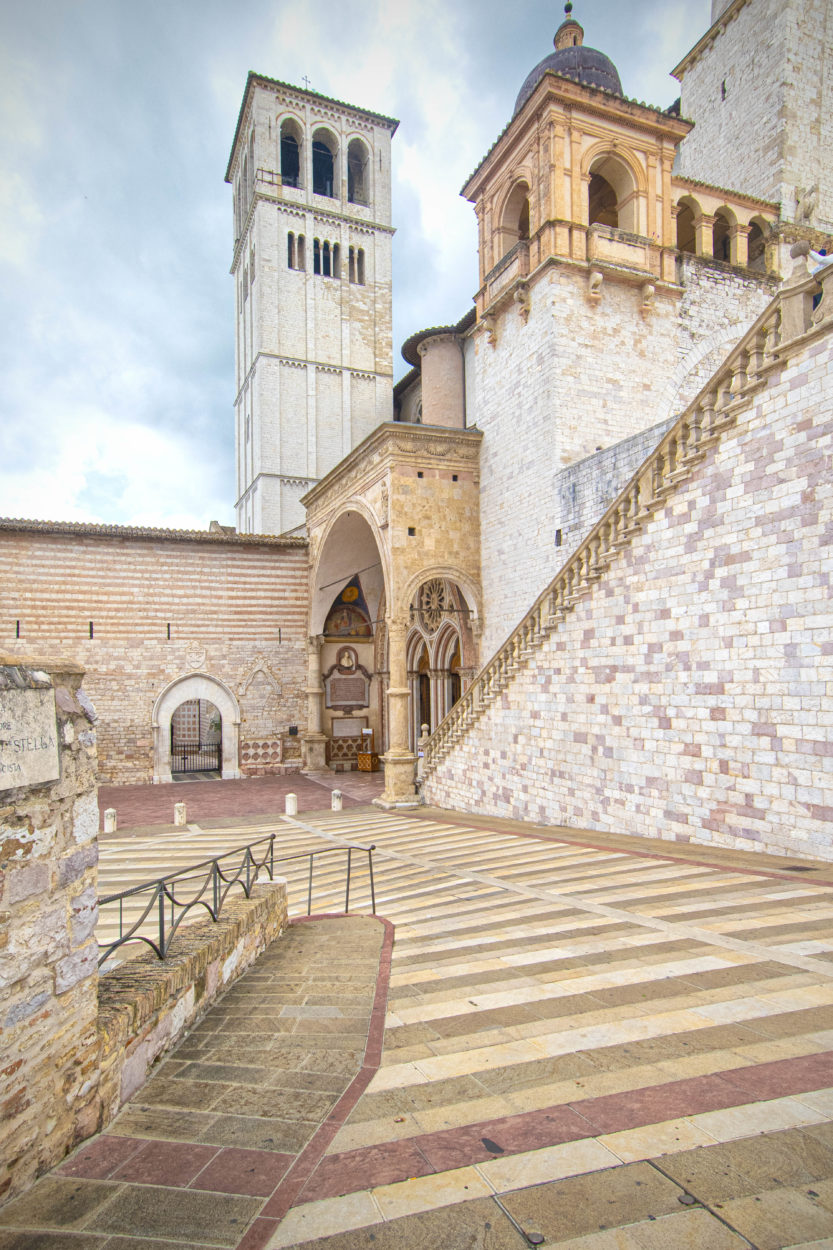
Assisi. Basilica of Saint Francis toward the lower Basilica and a view of the bell tower.
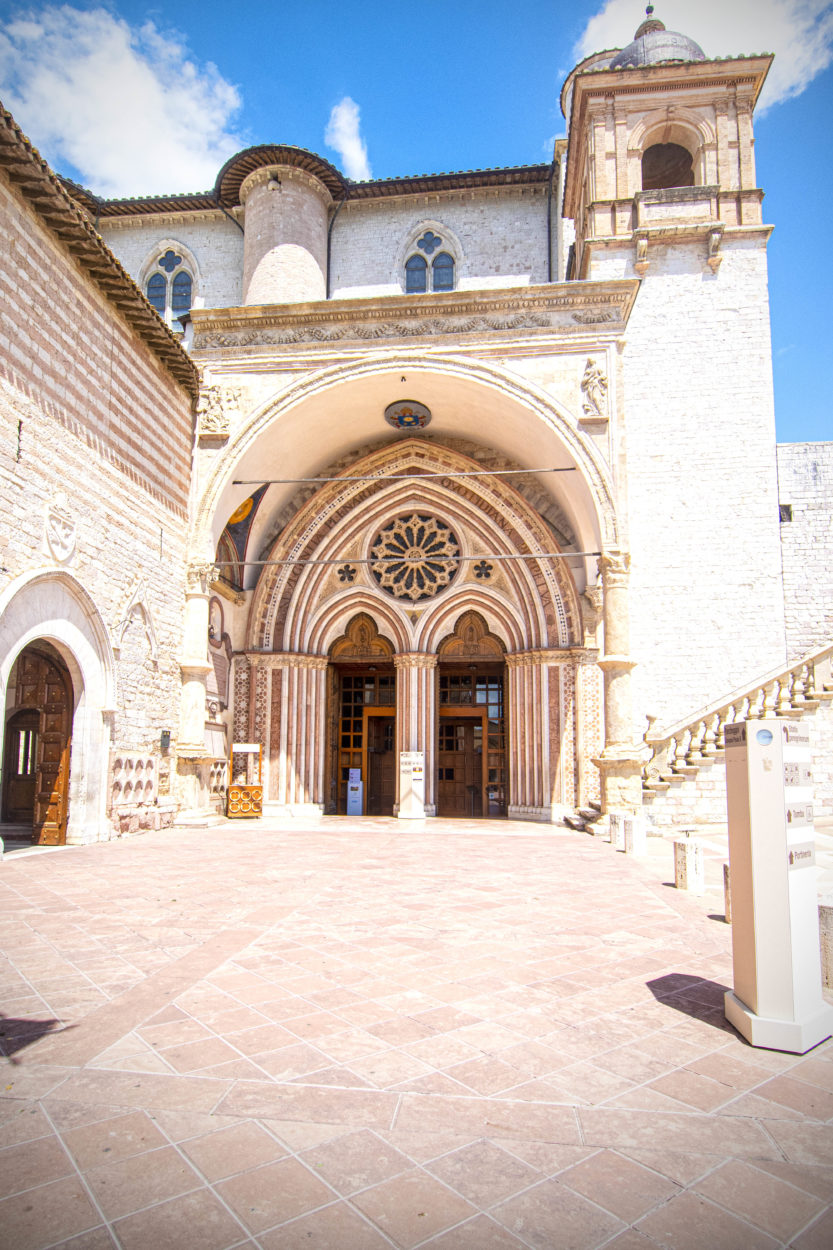
Assisi. Entrance to the lower Basilica of Saint Francis.
The Cathedral of San Rufino
There is a likely common assumption that Saint Francis is the patron saint of Assisi. That assumption would not be correct. The Cathedral of Saint Rufino venerates the first Bishop of Assisi as its patron saint. It is understood, this edifice was erected in the 11th century as a Cathedral (the place of the Cathedra, the throne of a Bishop) and is considered one of the finest examples of Italian Romanesque ecclesiastic style in Umbria. This Cathedral predates the Basilica of Saint Francis. The triangular top, in the Italian Gothic style, was added to the earlier Romanesque façade during the period of intense interest in Assisi following the canonization of Saint Francis.
According to tradition, this Cathedral contains the baptismal font by which the prominent Assisi family, the Bernardone, had their infant son, Francesco, baptized. Francesco, in later life became Saint Francis.
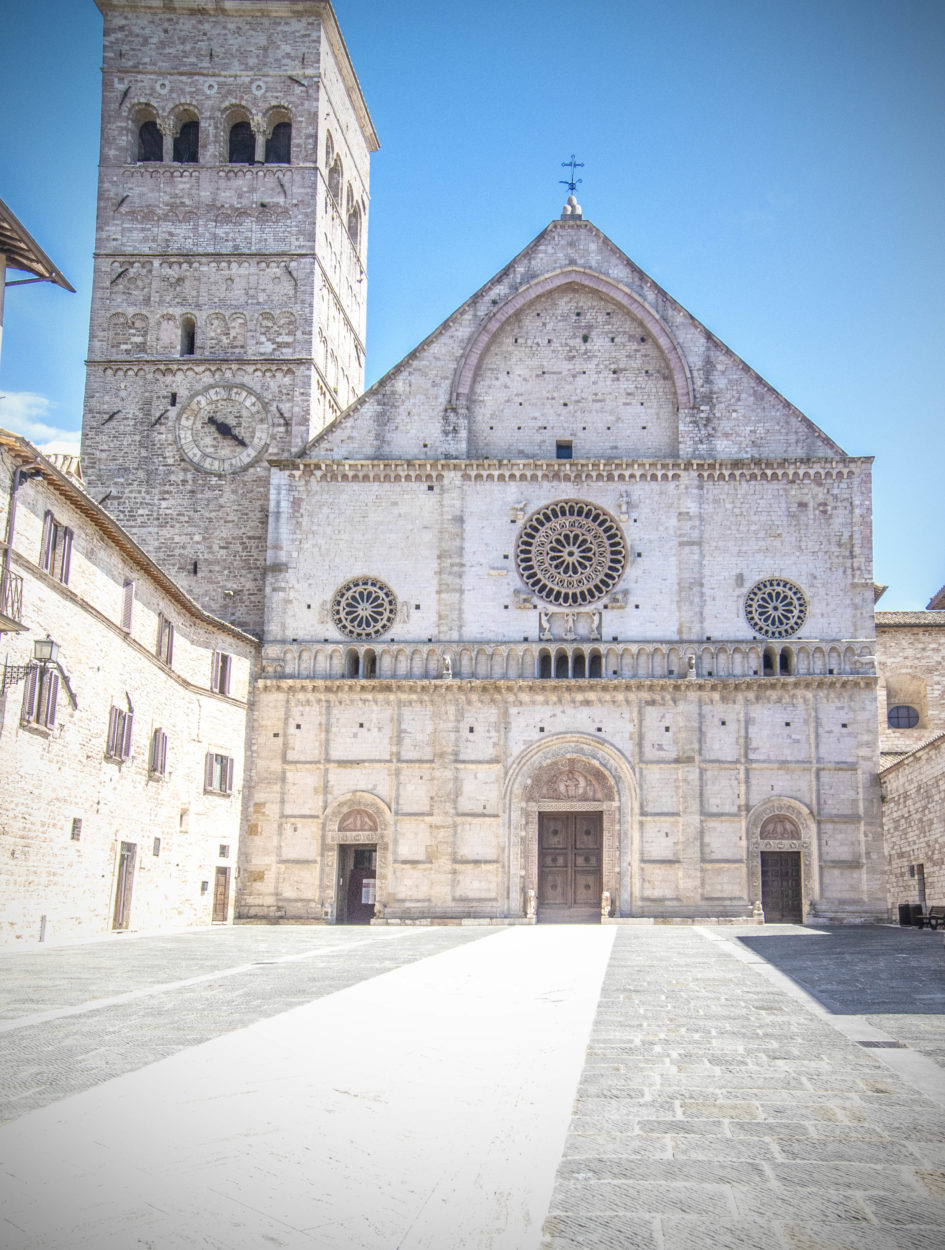
Assisi. Cathedral of Saint Rufino, the Patron Saint of Assisi.
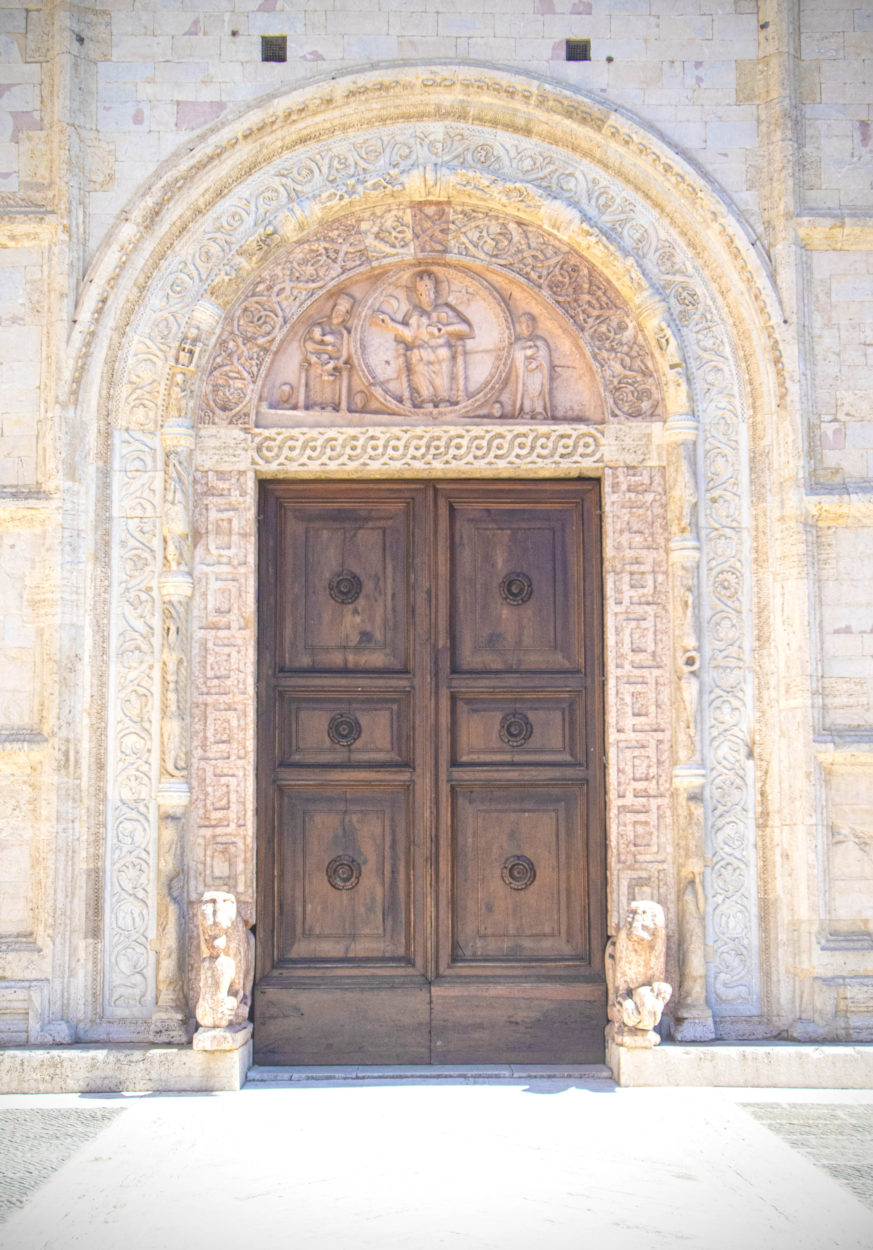
Assisi. Entrance portal to the Cathedral of Saint Rufino.
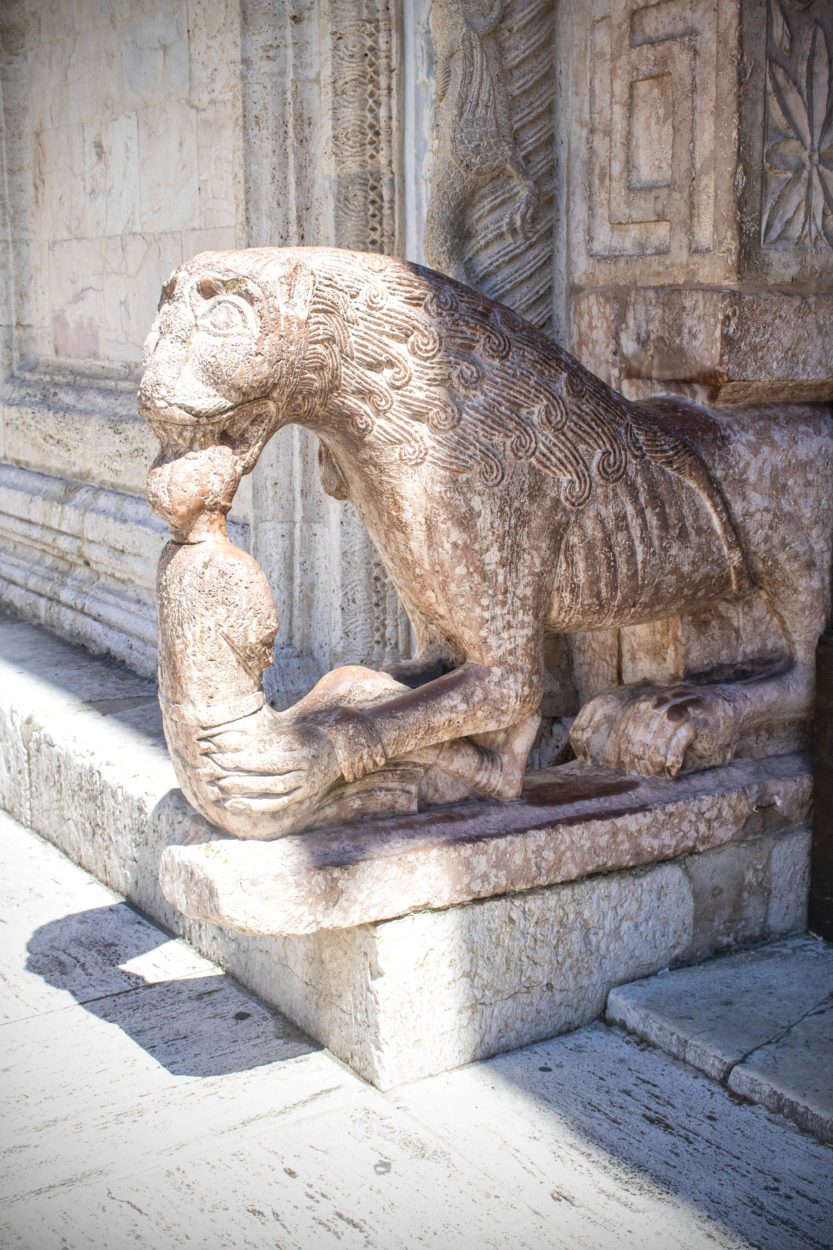
Assisi. Cathedral of Saint Rufino with entrance reminder to worshipers of the martyrdom of early Christians.
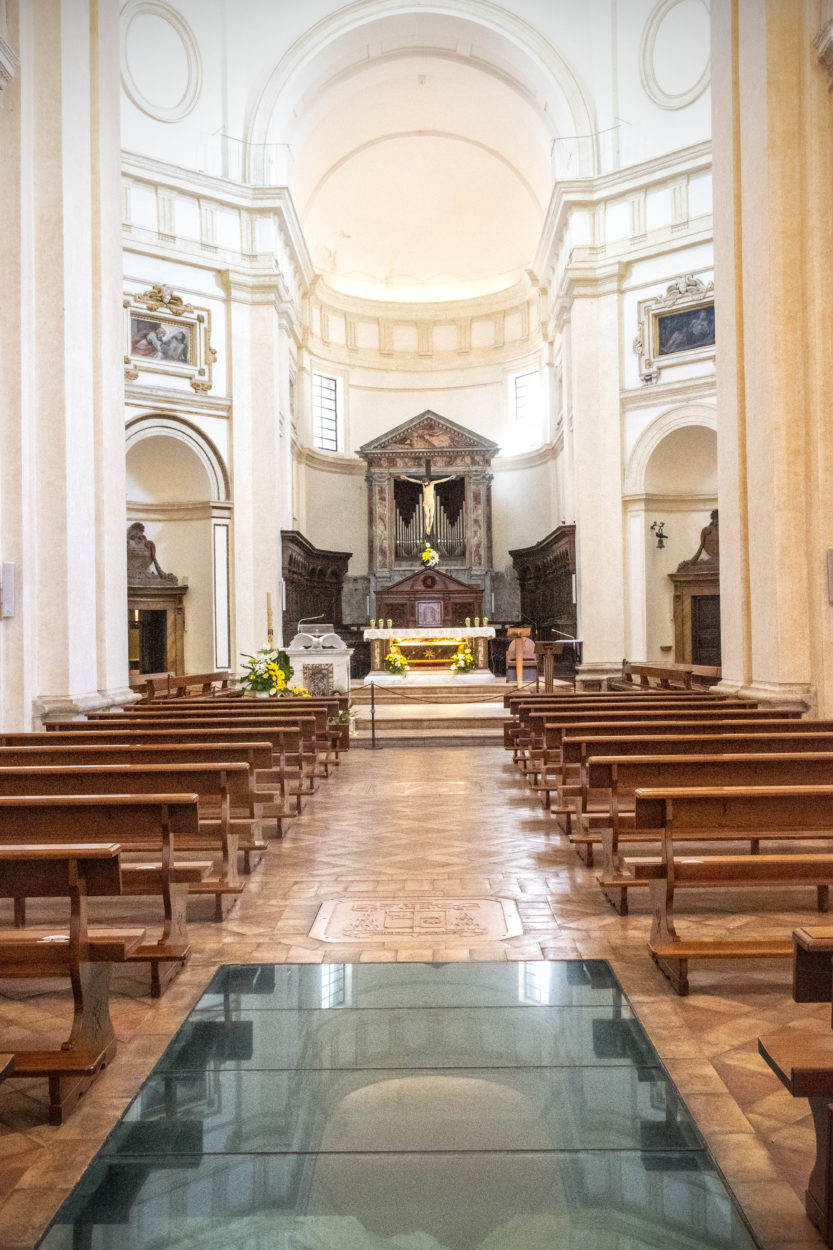
Assisi. Nave of the Cathedral of Saint Rufino modified from the Italian Romanesque into the baroque style that came into prominence in the 16th century.
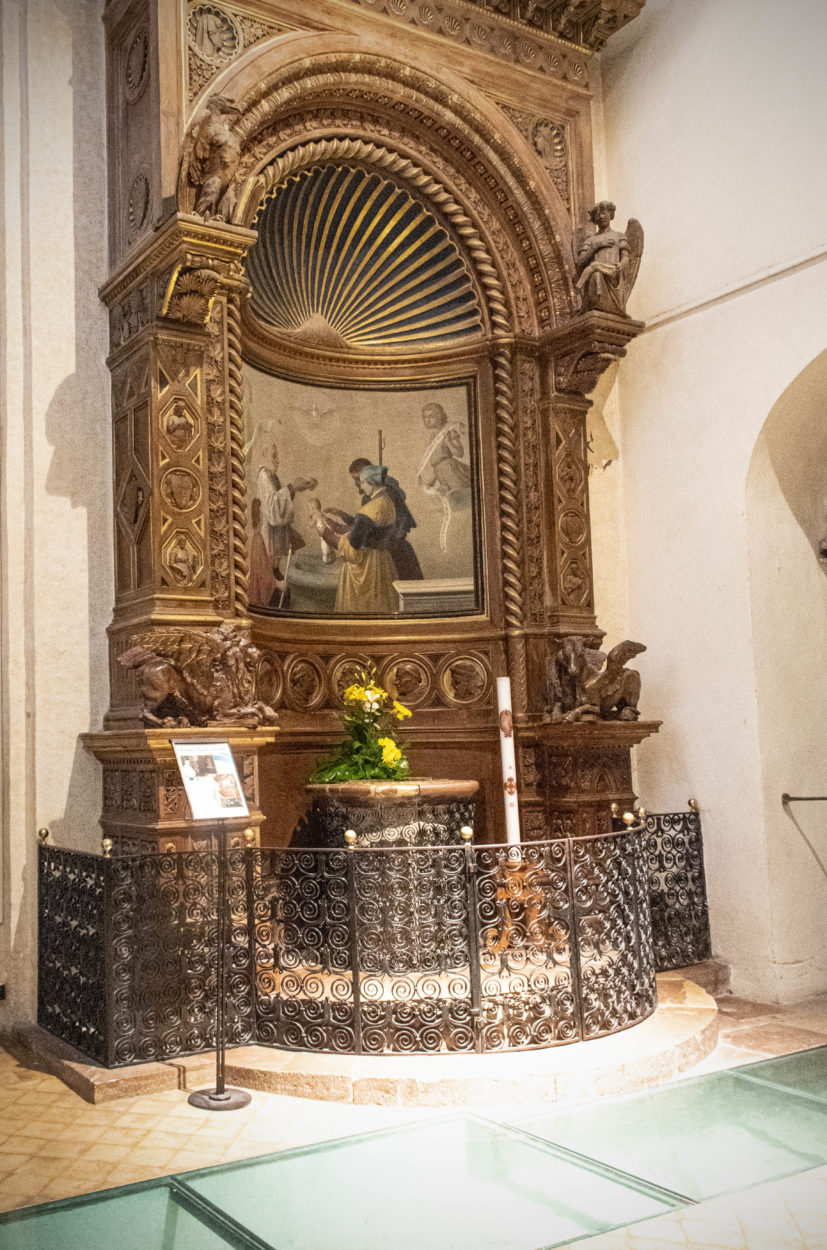
Assisi. Baptismal font in the Cathedral of San Rufino where tradition has it the infant, who was to become Saint Francis, was baptized.
The Basilica of Santa Chiara – Saint Clare
While there have been a number of women recognized for their piety through canonization by the church, particularly in the case of the dominant Cult of Mary, males seem to dominate in that recognition. Another significant exception in this regard is the life and work of Santa Chiara, Saint Clare, a contemporary of Francis. She became an early convert to the message preached by Francis and accepted a life of voluntary poverty in the service of God. Like Francis, she originally came from a prominent Assisi family of substance which she came to renounce.
Saint Clare ministered in parallel with the message of Francis and soon attracted other women to join with her in devoted service to God. Saint Clare became the founding figure of the Religious Order of Poor Clares. The Basilica of Santa Chiara is the mother church of this Order. It is understood to have been built in 1265, reflecting the Umbrian Italian Gothic style. In keeping with Franciscan values, the style reflects a simplicity to promote quiet worship and reflection. Over time, more decorative elements were added in veneration of this saint.
In the nineteen century, the humble tomb of Santa Chiara was discovered below the Basilica. This discovery resulted in the erection of a richly decorated, neo-gothic crypt. A sculptured figure of what is believed to be a likeness of the saint, is in repose above her remains. This Basilica and the Crypt of Santa Chiara remain an important pilgrimage site for the faithful to this day.
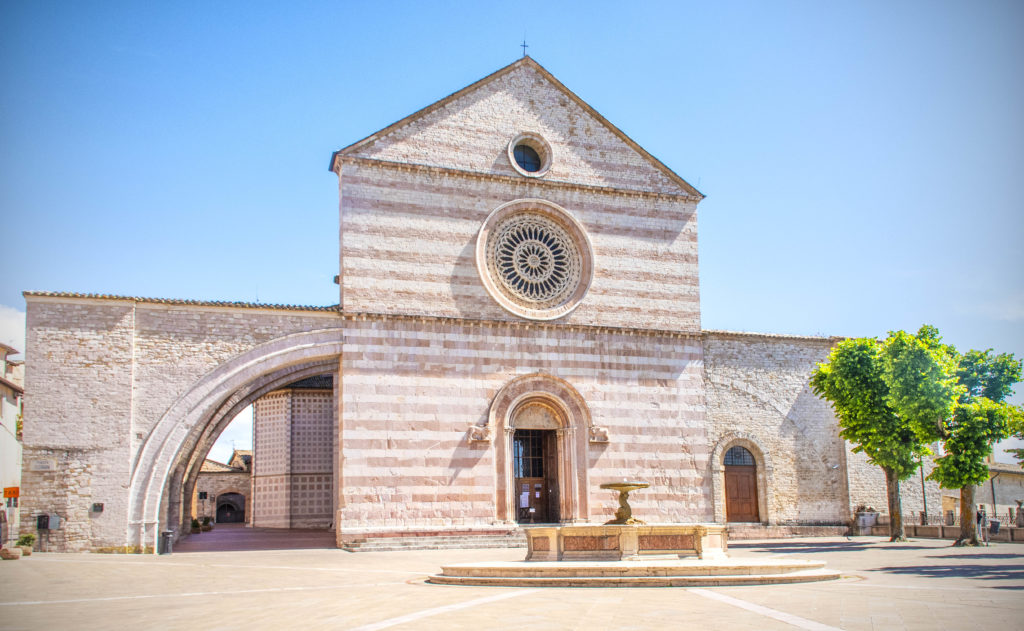
Assisi. Church of Santa Chiara [Saint Clare], the mother church of the Religious Order of Poor Clare’s.
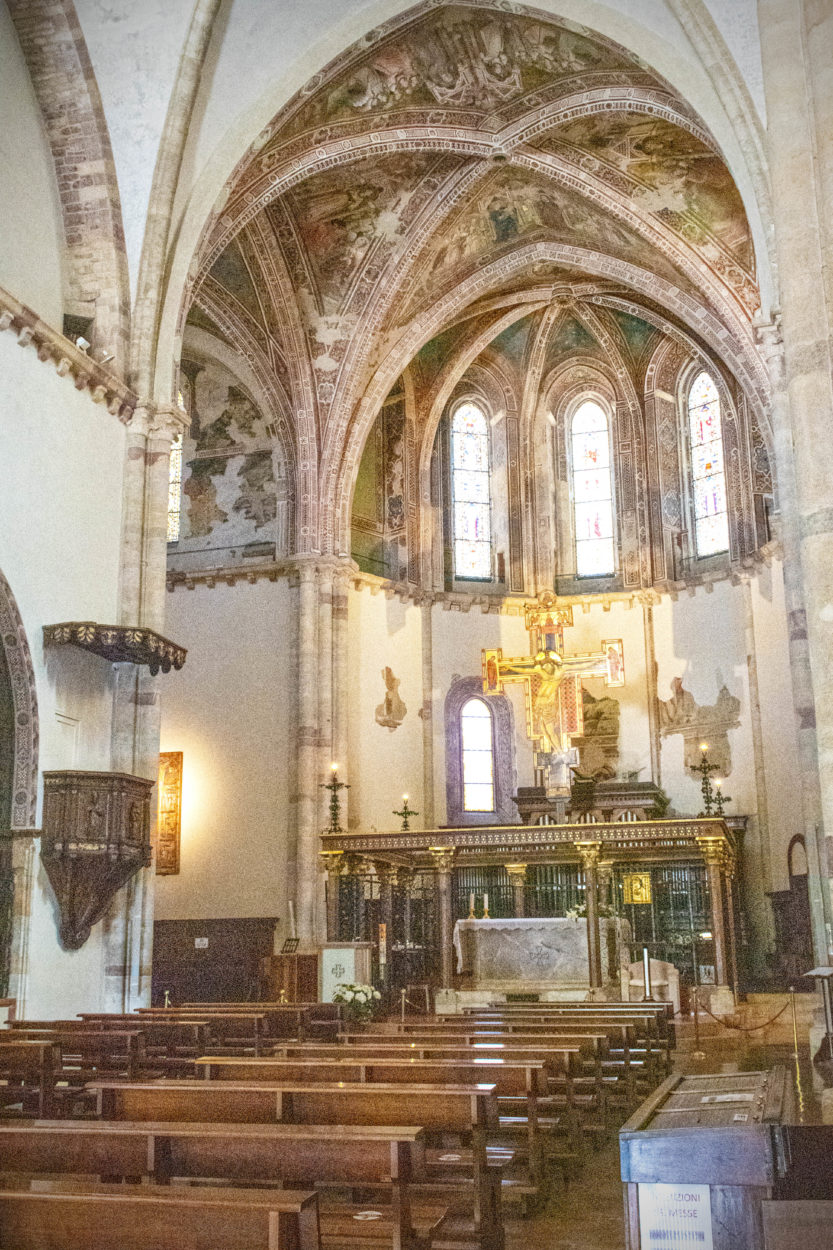
Assisi. Altar of the Church of Saint Clare.
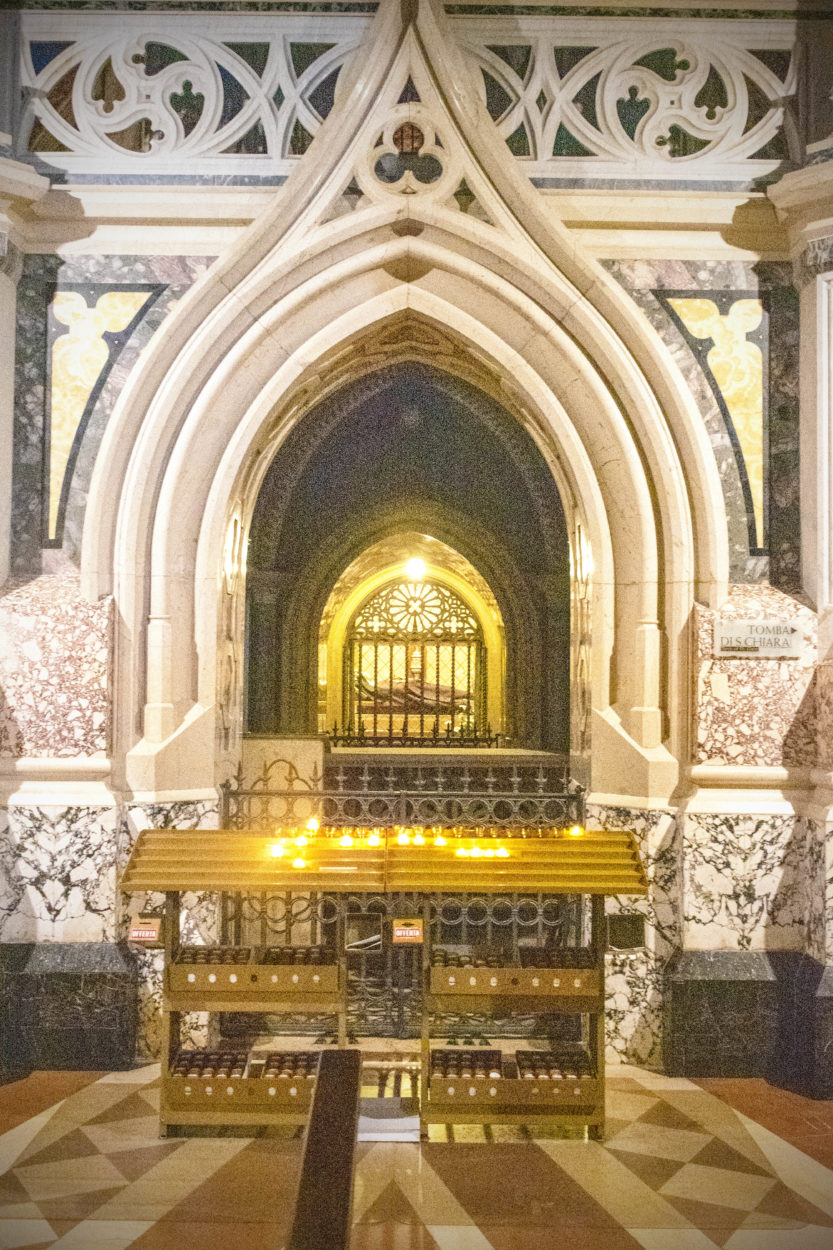
Assisi. Crypt in the Church of Saint Clare with a sculpted image above the remains of the Saint.
Basilica of Santa Maria degli Angeli – Saint Mary of the Angels
Within this large church is believed to be the Porziuncola Chapel understood to have been restored by Saint Francis and to have been the site where he began his ministry, was the original seat of his subsequent order and where he is believed to have died in 1226.
This large basilica, in the baroque style, is understood to have been erected in the 16th century literally on top of the Porziuncola Chapel. Tradition has it Saint Francis rebuilt this chapel from what was a ruin into what became a site from which he could minister in God’s name.
The imposing structural volume of the basilica has been recognized to be the 10th largest church in Christianity. The contrast between the volume of this edifice and the humble chapel within its walls, is astounding. That contrast exemplifies the distinction between the humble origin of the Franciscan Movement and its ultimate influence. Francis is understood to have initially understood a revelation he received to ‘rebuild the church’ as applying to this chapel. He later saw that admonition to rebuild the church to the larger Christian Church – a mission to which he dedicated his life.
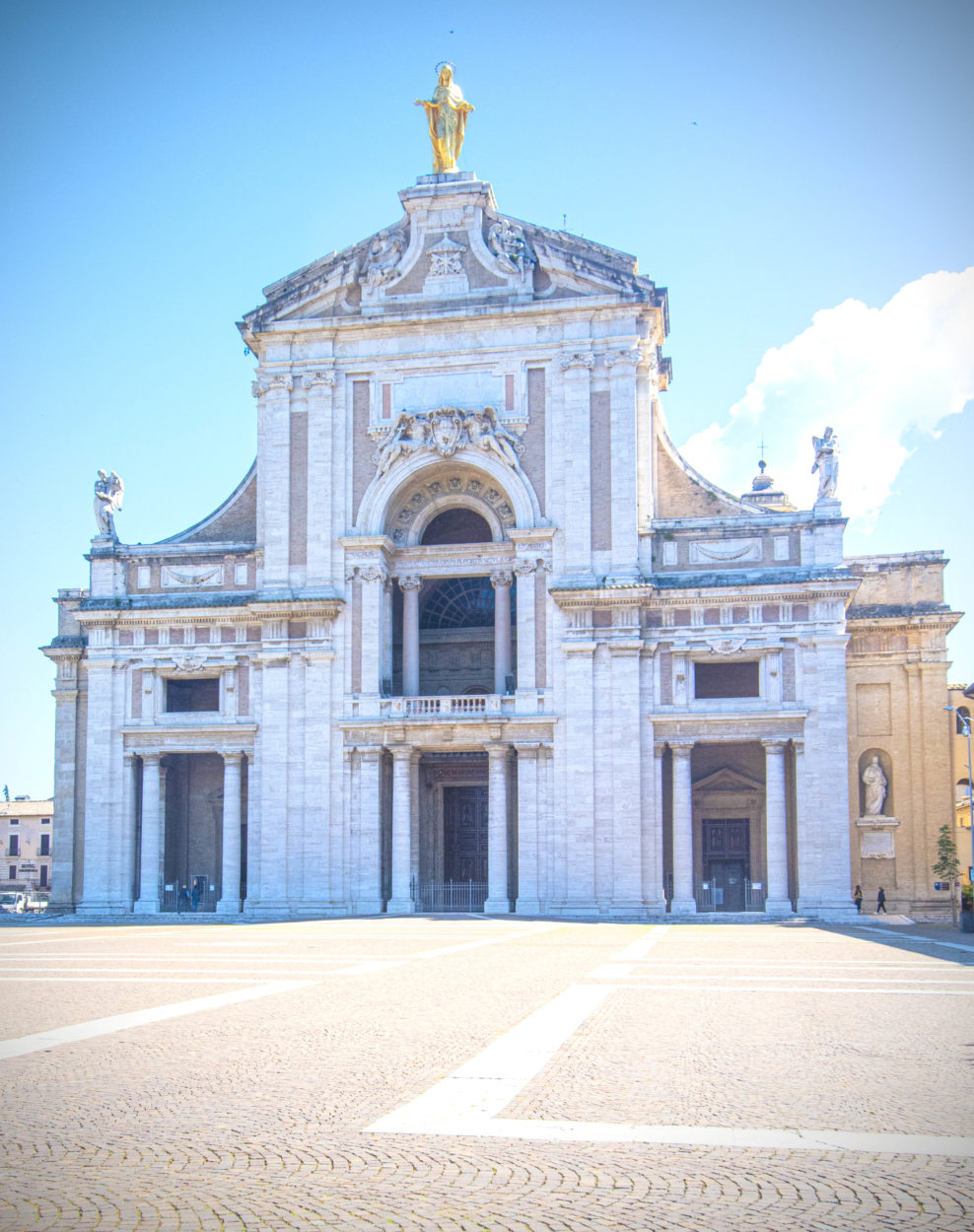
Assisi. Santa Maria degli Angeli (Saint Mary of the Angels). Within this church tradition has it, is the stone Chapel rebuilt by Saint Francis of Assisi very early in his ministry.
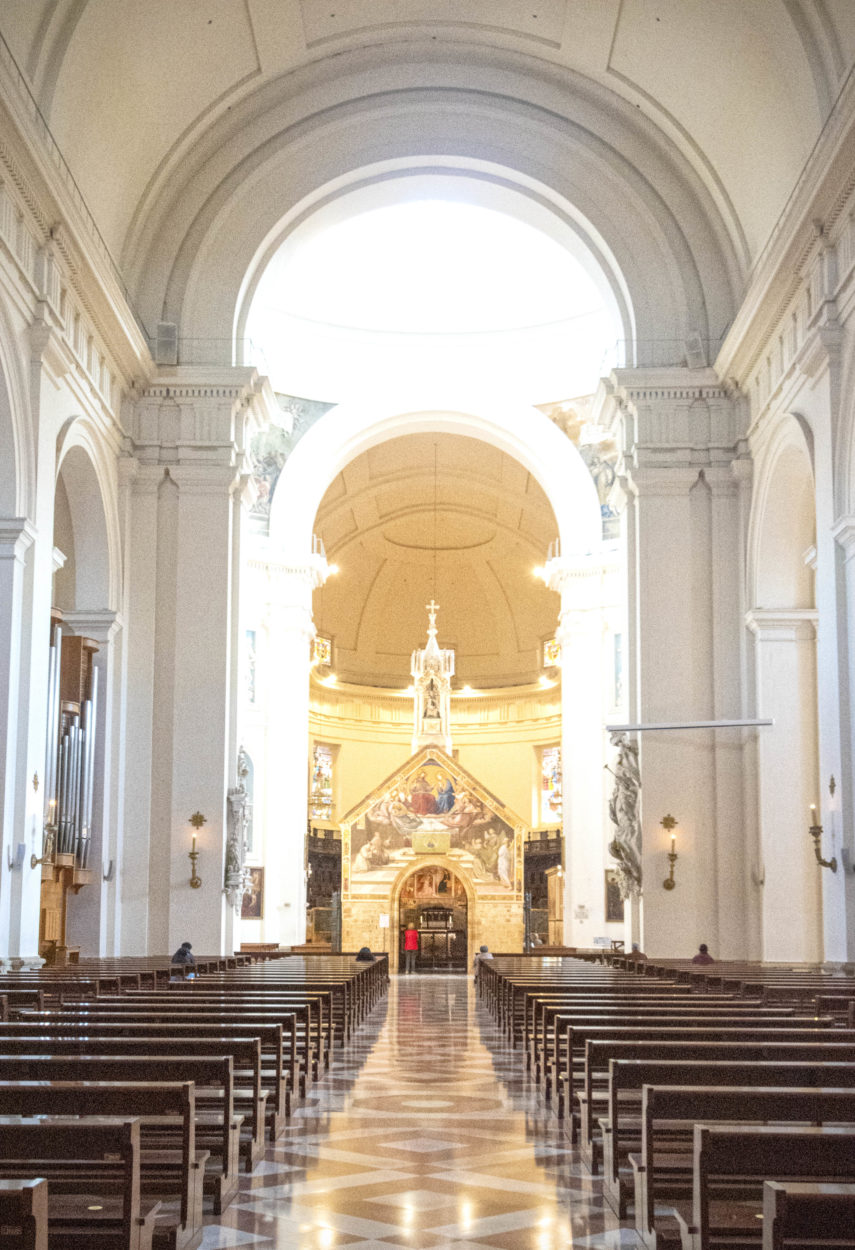
Assisi. The baroque nave of the Church of Saint Mary of the Angels with the stone Porziuncola Chapel tradition has it, was rebuilt by Saint Francis of Assisi from a ruin.
The Rocco Maggiore – The Large Fortress
Dominating the hilltop overlooking Assisi is the Rocco Maggiore, the large fortress. This imposing structure dating from the 14th century is emblematic of the period of the Middle Ages. What we now know of as Italy was then, a fragmented patchwork land under the domination of local lords who were in a near constant competitive struggle to dominate each other. The result during this period, was nearly constant warfare and bloodshed. The domination of the landscape in Italy by ‘hill towns’ is attributable to the reality these positions were optimal for defensive purposes
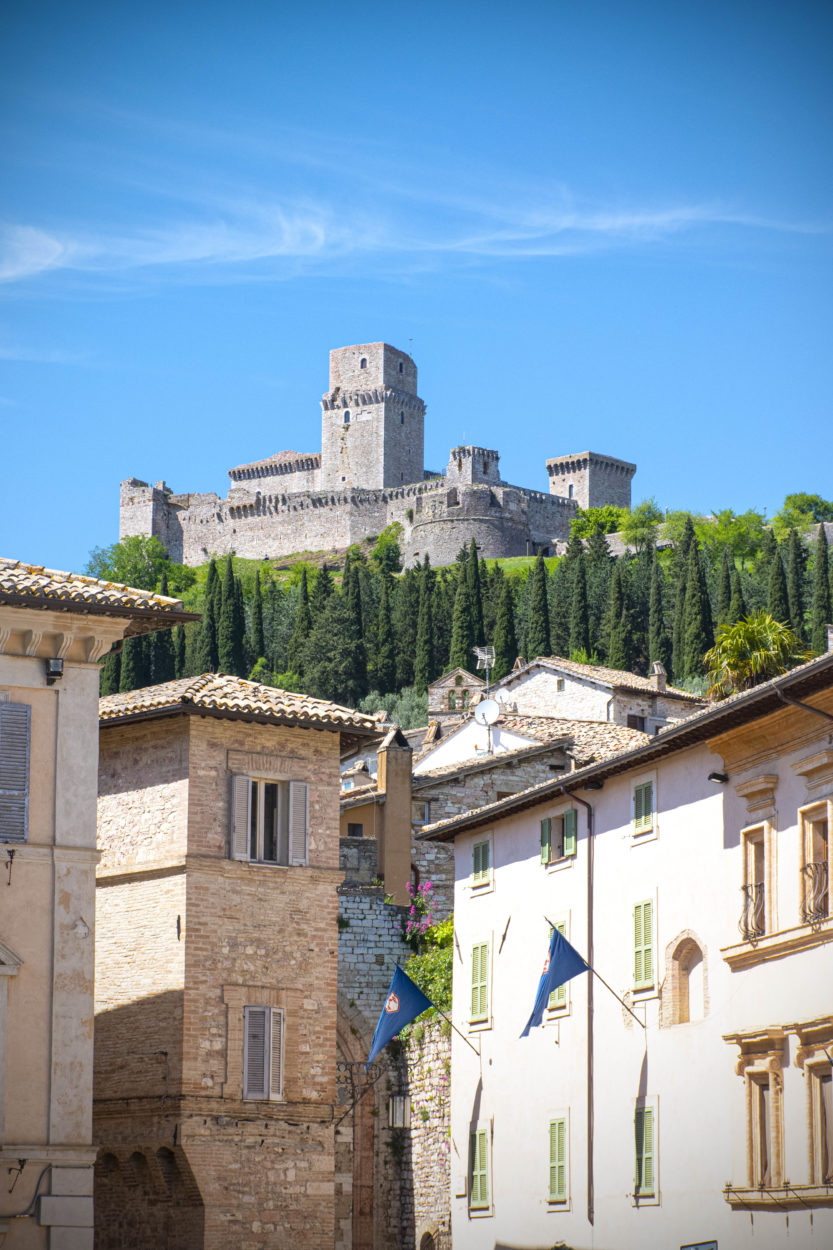
Assisi. Fortress (Rocca) Maggiore above Assisi.
ORVIETO
Long before Rome burst onto the stage of history, what is now Central Italy west of the Apennines, was inhabited by a different people, the Etruscans. These were a highly sophisticated people, although their exact origins are not known with specificity, there is a belief they were originally of an Indo-European origin going back into antiquity. Their presence can be traced back more than a millennium prior to the current era. They were the dominant culture in what is now parts of Tuscany and much of Umbria. A thriving center of Etruscan Culture was in the south of what is now Umbria, centered in Orvieto, called Velzna in Etruscan times. Etruscan Velzna thrived between 900 BCE until it fell after a protracted siege by the military expansions of the Romans in 264 BCE.
This was a return visit to Orvieto for us, this time as residents in Italy. We left our comfortable and pleasant hotel in Assisi in mid-morning, by car. The connection between Assisi and Orvieto is on main, largely flat roads. The trip was programmed to take barely two hours. However, to their credit, even in difficult economic times, Italy is paying attention to infrastructure. That is the good news. The bad news is on a road trip, an unanticipated, significant detour around road repairs can be encountered. The circuitous detour through the hills added nearly an hour to the trip but we eventually arrived, no worse for the inconvenience, in Orvieto.
The selection rationale of Orvieto as a settlement in pre-history is obvious. Orvieto, and the earlier Velzna, is set on a hilltop plateau rising 300 hundred meters above the surrounding terrain. The hilltop itself is generally flat with modest changes in elevation. The slopes leading up to the hilltop are very steep making it an ideal defensive site.
Arrival in Orvieto suggests avoiding any consideration of using your own car on the Orvieto hilltop. Many streets are narrow and pedestrian only. Parking is extremely limited. If arriving by car or train, the rail station on a main north-south line between Rome and Florence is located near the north-east base of the Orvieto hilltop. The rail station adjoins a large, free vehicle parking area. A short distance away is the station of a funicular rail system running frequently to Orvieto above, connecting with a convenient bus stop serving the town center.
The other alternative is the one we used. At the south-west base of the Orvieto hilltop is the Campo della Fiera, a large, paid parking structure. A reduced 24-hour rate of 12 Euros is applicable. There are two options from this covered garage parking area to reach the upper street level of Orvieto. One is a series of escalators connected by well lighted tunnels with a parallel stairway. A note of caution, the escalator is ‘up’ only.
The second alternative is an elevator depositing you not far away from the upper escalator exit and provides the option for a mechanized descent back to the garage. On arrival, we chose the escalator, up only option as it took us directly into the Piazza de Ranieri, the location of our hotel, the Palazzo Piccolomini. On departure, we opted for the elevator rather than the long flight of stairs.
Orvieto is a very walkable town. Compared to other Italian hill towns, the grades are very moderate. The overall shape of Orvieto, seen from above, is a long oval. The Corso Cavour is the main connecting artery running from the Piazza della República all the way to the Piazza Cahen and the upper station of the funicular system. There are a number of interesting sites in Orvieto, but the highlight has to be the Cathedral, or Duomo, of Orvieto. It is easily reached off the Corso Cavour on the Via Duomo.
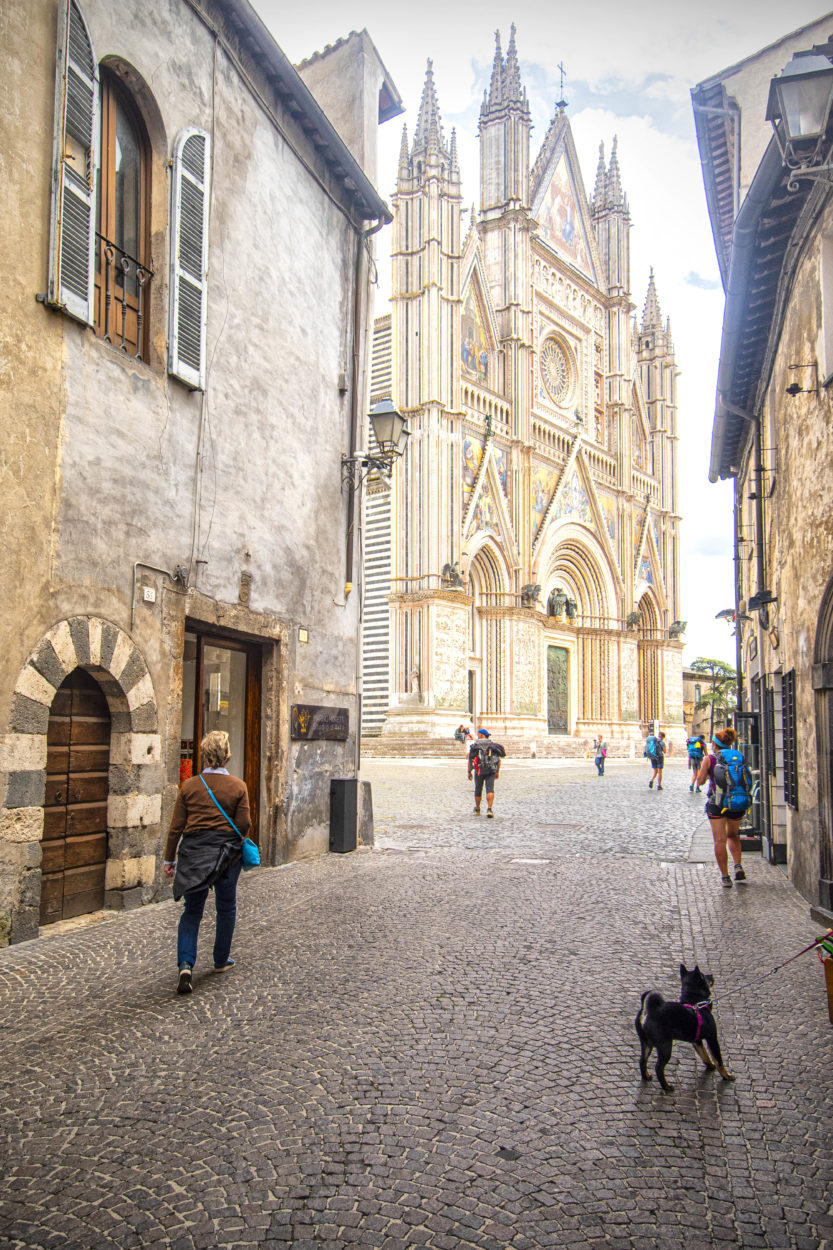
Orvieto. On the Via Duomo into the Piazza of the Orvieto Cathedral (Duomo). Arlene is on the left.
The Cathedral (Duomo) of Orvieto
The Cathedral is considered an exceptional example of the Italian Gothic, with Romanesque and even Baroque overtones. The bright, ornate façade of this building is mesmerizing. The eye is greeted by Gothic-styled pinnacles, spires and pointed arches, interspersed with shining mosaics, sculptural works and stained glass set in a rose window.
The Cathedral of Orvieto represents a composite of ecclesiastical architectural styles that came to dominate over the long, 300-year history of the construction of this structure. The imposing, highly decorated façade of the Cathedral represents a high point in a presentation of the Italian Gothic style. The Cathedral was begun in 1290 when the Romanesque style was dominant and determined the core design of this building. During the long development of this Cathedral, architectural styles evolved. The imposingly ornamented façade in the Italian Gothic, was added onto the main, Romanesque-styled structure behind it.
During the Counter-Reformation enthusiasm for Baroque decoration, elements were added to the interior of the Cathedral only to be removed later to recapture the original sense of an unencumbered volume. The sense of volume was enhanced by building the walls with alternating dark and light stones arranged in a predominating horizontal pattern. The result is to create a visual impression of increased horizontal space. Of the Baroque elements added, the ornate organ and the predominance of statuary framing the center of the nave are remaining elements.
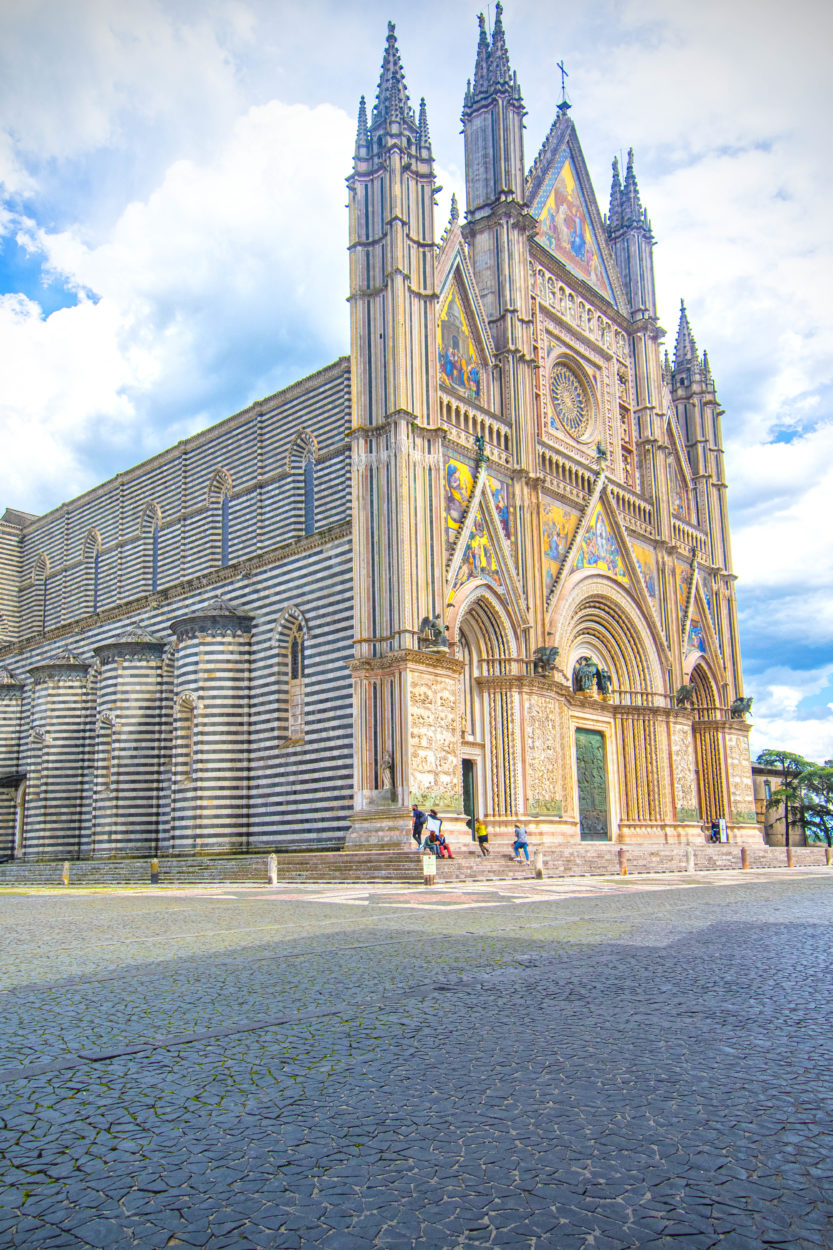
Orvieto. The Cathedral (Duomo) of Orvieto in the Italian Gothic style.
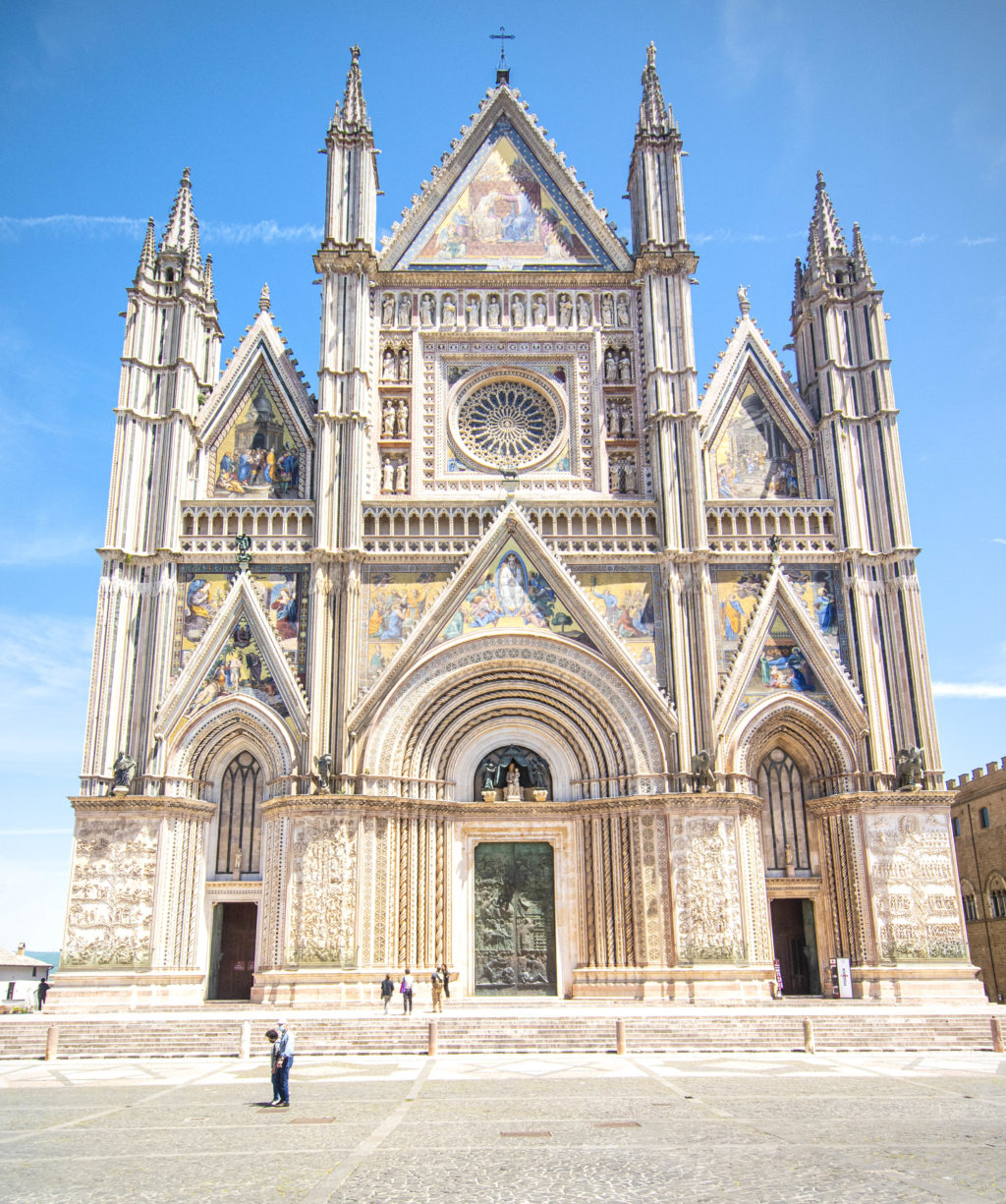
Orvieto. The façade of the Cathedral (Duomo) of Orvieto. A masterpiece of Italian Gothic decoration.
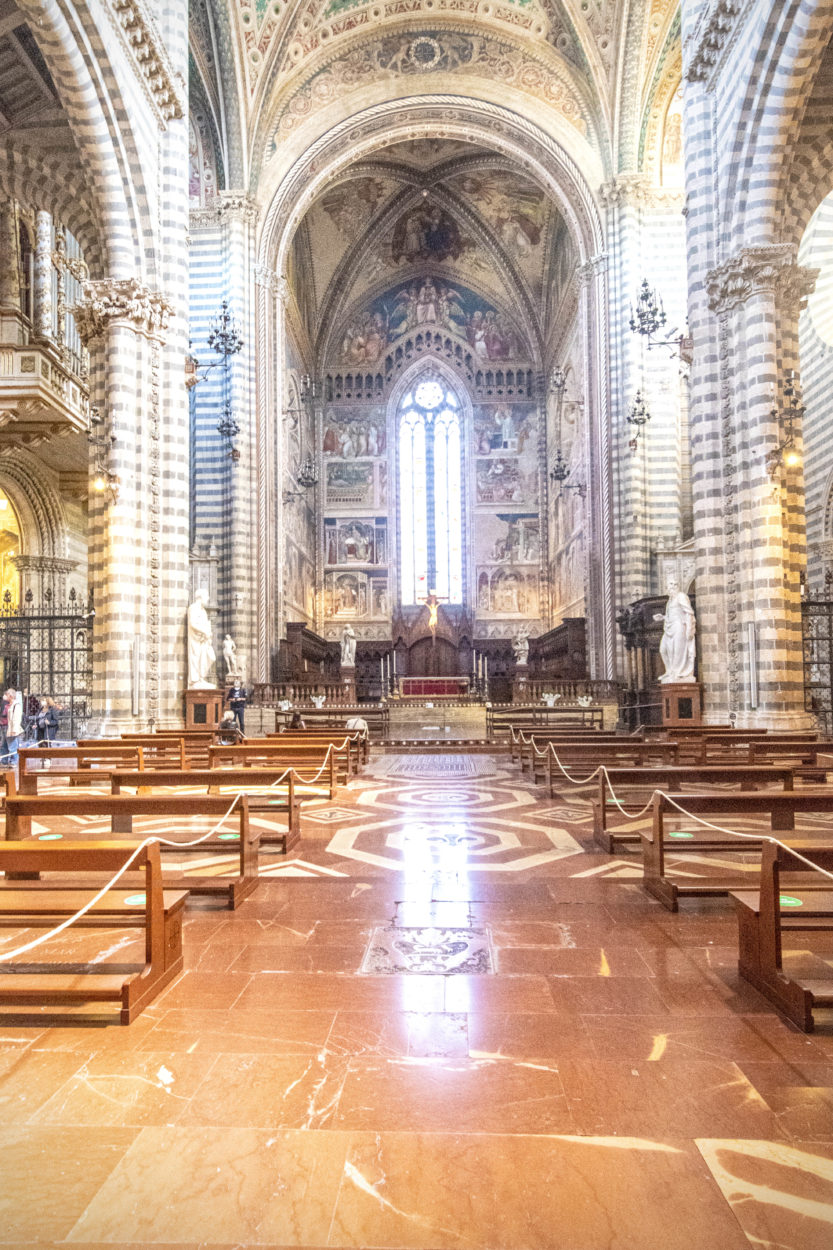
Orvieto. The Nave of the Cathedral (Duomo) of Orvieto in Italian Gothic with baroque overlays.
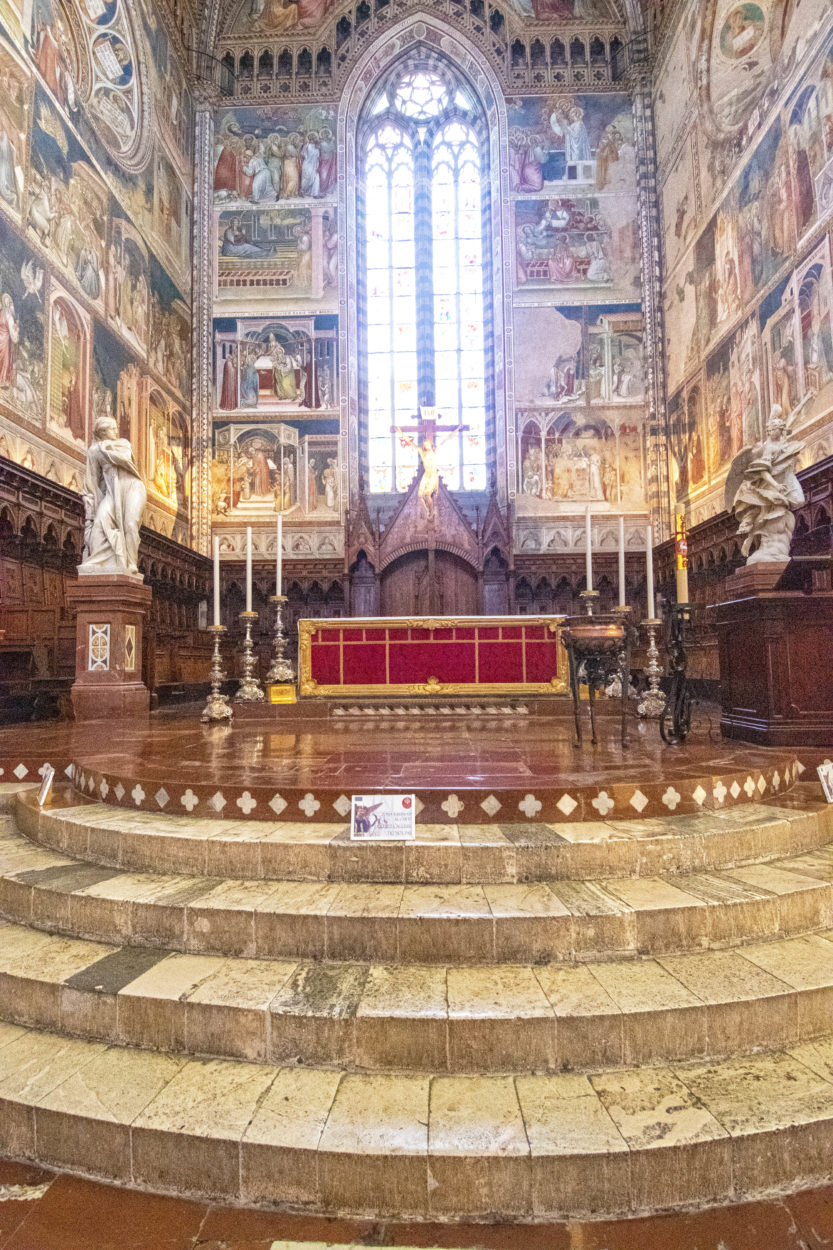
Orvieto. The Presbytery and altar of the Cathedral (Duomo) of Orvieto.
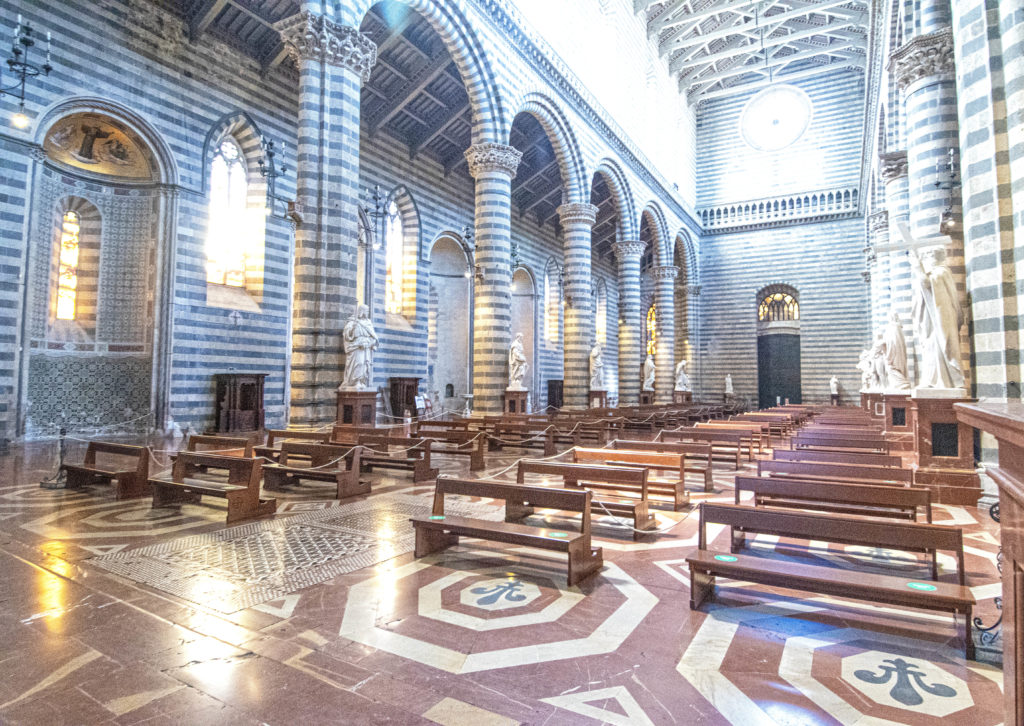
Orvieto. Nave of the Cathedral (Duomo) of Orvieto with statuary and alabaster windows.
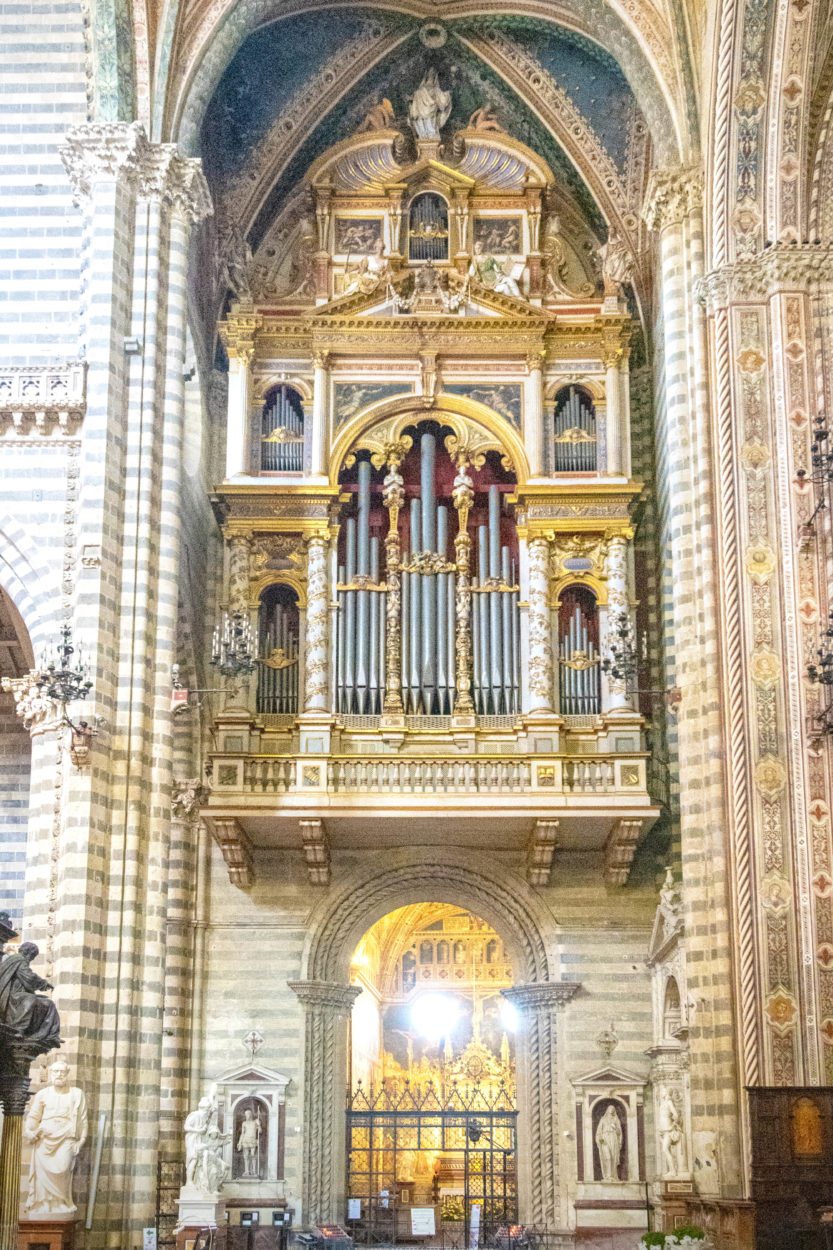
Orvieto. Baroque organ of the Cathedral (Duomo) of Orvieto.
Chapel of San Brizio. Found in the right transept of the Cathedral, is the Chapel of San Brizio. This space is saturated in frescoes to illustrate the Christian story to a pre-literate society. Some of Italy’s most renowned Renaissance painters contributed to these frescoes. Among them, Fra Angelico and Luca Signorelli. The fresco of the Day of Judgment and Life After Death were painted by Signorelli between 1499 and 1504.
These highly detailed and densely decorated frescoes portray the traditional Christian story as a continuum. The quality of their preservation is exceptional. It continues to amaze us how accessible significant works of art are in Italy. We were in this incredible space completely alone with no oversight. The works were not behind any protection.
It is encouraging, with the promotion of travel, more people are afforded the opportunity to be exposed to some of the more notable artistic achievements of human culture. Unfortunately, increased accessibility does not always bring with it a sense of enhanced respect these works deserve.
We find ourselves concerned by some visitors to special cultural sites who ignore the posted restrictions against the taking of flash photographs. The intensity and wavelength of the light from photo flashes, including from cellphones, have a potential to alter the delicate pigments of these historic artworks.
Regardless of one’s own approach to matters of religion, it should not be forgotten many of these sites hold a special place in the spiritual lives of the people of that community.
The custodians of major works of art are caught in a dilemma of wishing to have the lives of more people enriched by access to these works, but that objective is offset by the resulting potential damage that can be done by the, not always responsibly thought out, attention the works receive. We do not envy the responsibilities of those charged with protecting these works.
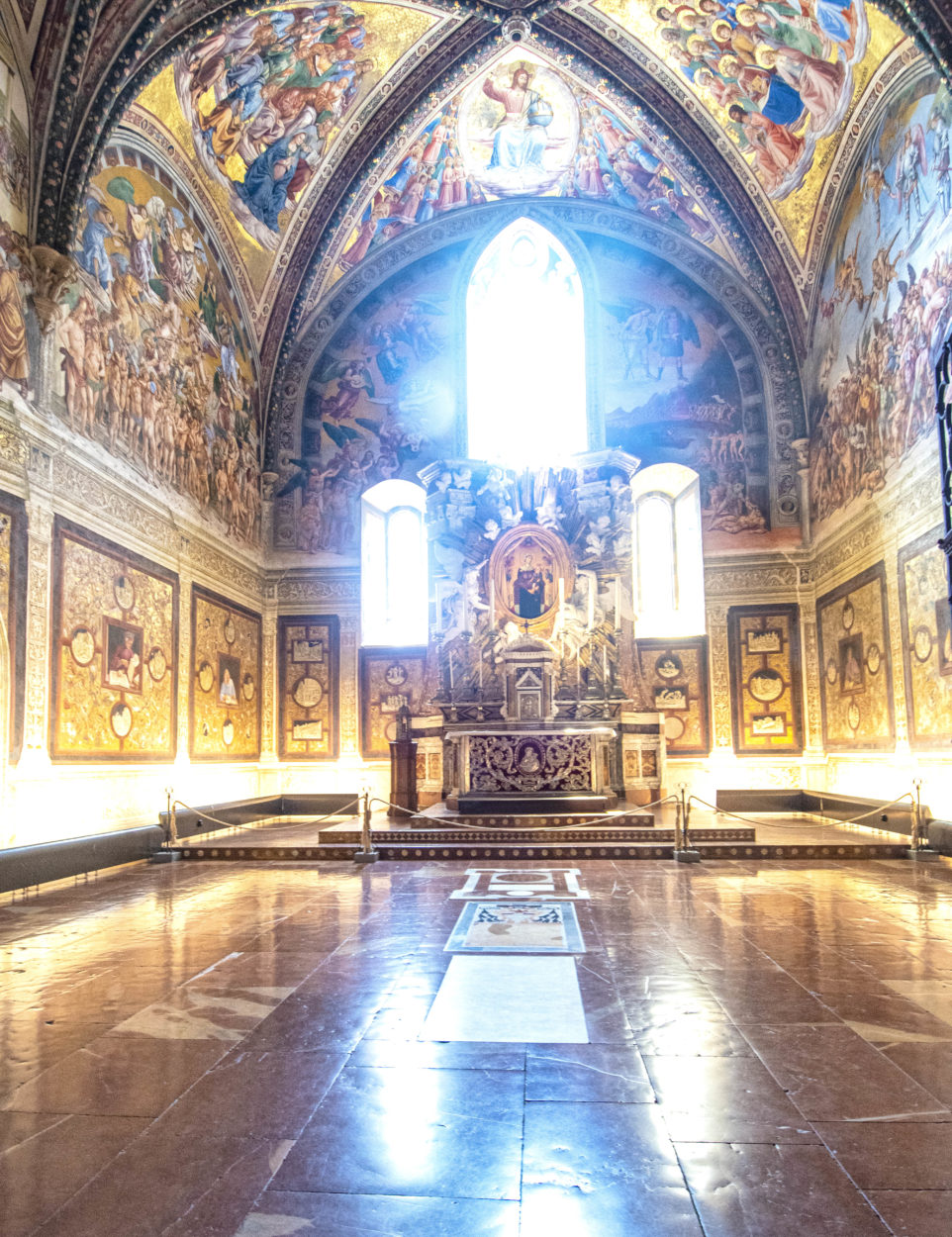
Orvieto. Cathedral (Duomo) of Orvieto side Chapel of San Brizio featuring frescos by Luca Signorelli.
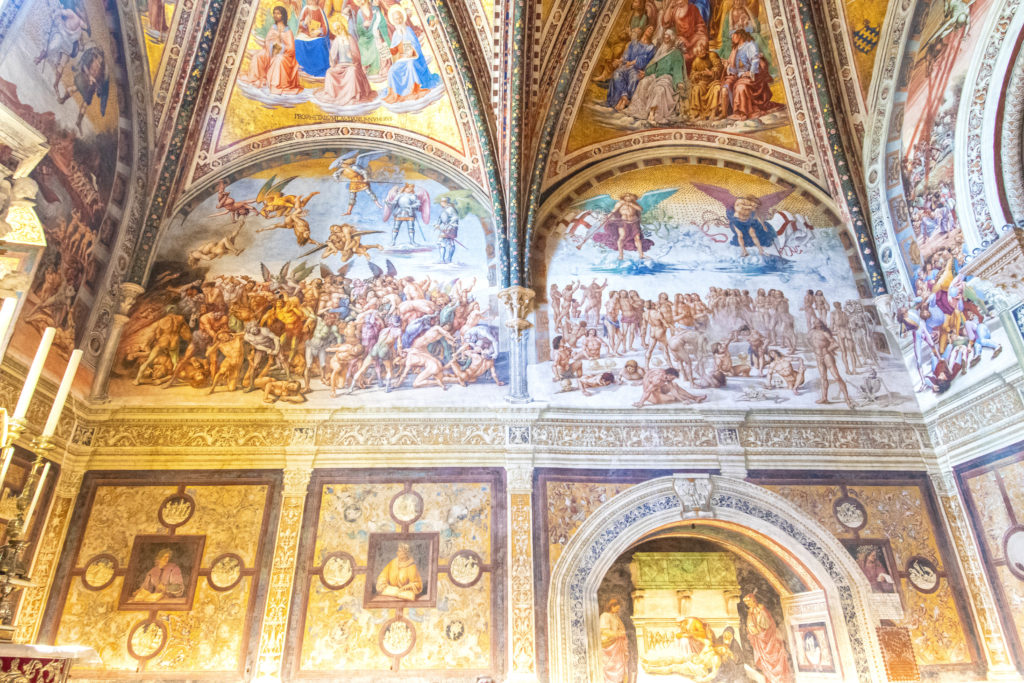
Orvieto. Luca Signorelli’s frescos of The Last Judgement in the San Brizio Chapel of the Cathedral (Duomo) of Orvieto.
Baptismal Font of the Cathedral of Orvieto. This ornate baptismal font at the rear of the nave of the Cathedral is an illustration of how changes in the dominant artistic styles of a period, can affect pre-existing works. The upper portion of this impressive sacramental element displays a later Italian Gothic embellishment applied to an earlier Italian Romanesque presentation.
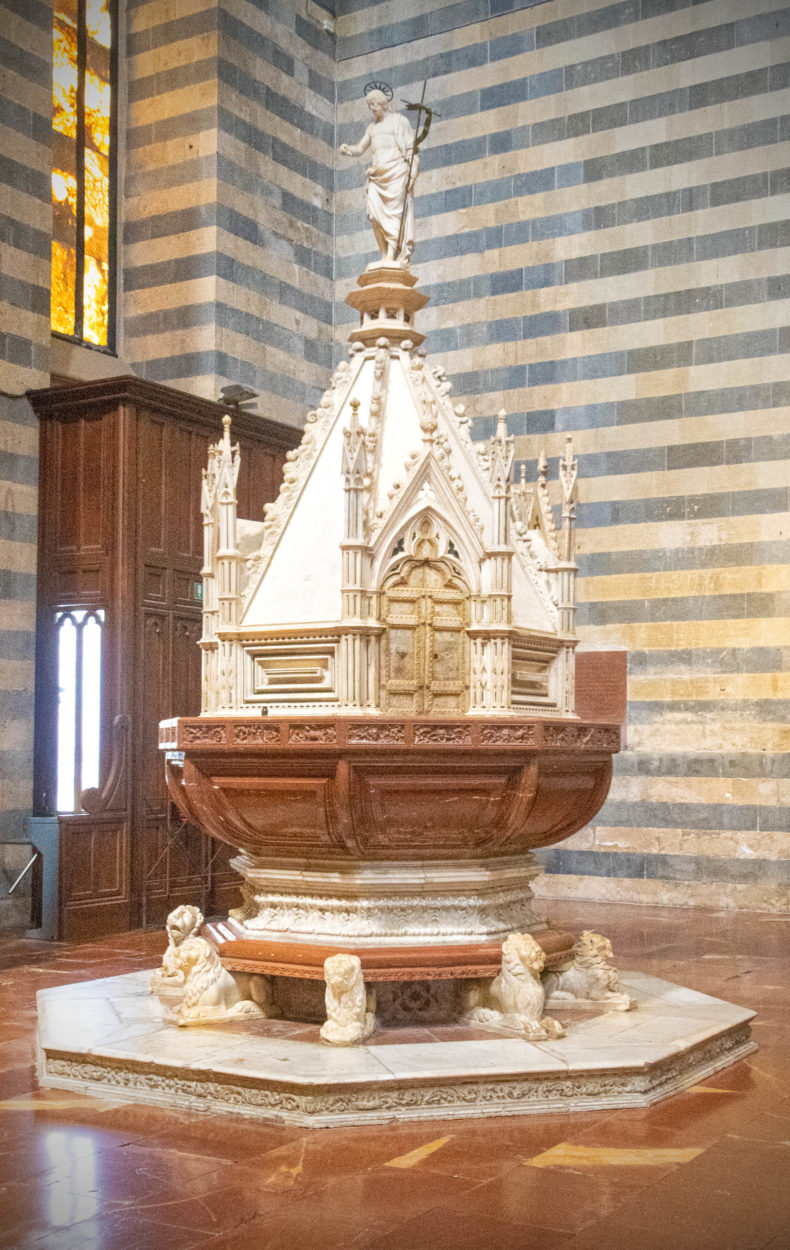
Orvieto. Italian Gothic baptismal font in the Cathedral (Duomo) of Orvieto.
Pre-Roman, Etruscan Orvieto. There are several other sites dating from the Middle Ages worth exploring in Orvieto. The relatively gentle terrain for navigation on foot makes that easy. But no visit to Orvieto is complete without an exploration of some of the remaining elements of the Etruscan culture still in evidence.
Among them is to explore how the Etruscans took advantage of the characteristic of the rock that is native to Orvieto, as well as much of Italy. It is called Tuffa (or Tufo in Italian). This is a generally light-tan colored, volcanic rock which owes its existence to flows of molten lava coming to the surface and cooling relatively quickly.
The topography of the Italian Peninsula owes much of its landscape from the fact this land sits in close proximity to the junction between the earth’s massive, moving Eurasian and African plates of the surface crust. The massive outer layers of the planet upon which we live, are in near constant motion and interacting with each other. The ‘Plates’ are literally ‘floating’ on molten lava beneath the surface.
The dynamic interaction between these two moving plates generates tectonic heat and pressure forces on the surface crust which accounts for the uplifting of the Apennine mountain chain as well as the predominance of rocks of volcanic origin in Italy. This rock is relatively easy to carve and shape initially when unearthed but hardens further after exposure to the environment. These characteristics explain the value of this material in building and its initial ‘workability’ in excavations.
Any settlement of human habitation has to depend on a reliable source of water to function. A water independence became all that more essential during times of military siege warfare. The difficult to scale slopes of the plateau of Orvieto have made a direct military assault impractical. The preferred military solution in an attack, would have been to attempt to starve the population into capitulation.
But adequate water storage reserves and storage of food items created a favorable waiting game for the Etruscans of Orvieto. That condition prevailed until the final Roman victory after a very prolonged siege. Prior to that, the Etruscan inhabitants on top of the plateau seem to have won out the waiting stalemate more often than not.
There are informative tours of the ‘City Underground’ featuring excavations from Etruscan times that illustrate incredible engineering resourcefulness and surprises including an unground pigeon raising space complete with actual ‘pigeonholes’ carved in the wall. A large and very deep well and cistern system includes two concentric stairways permitting two-way traffic to have access to a changing water level.
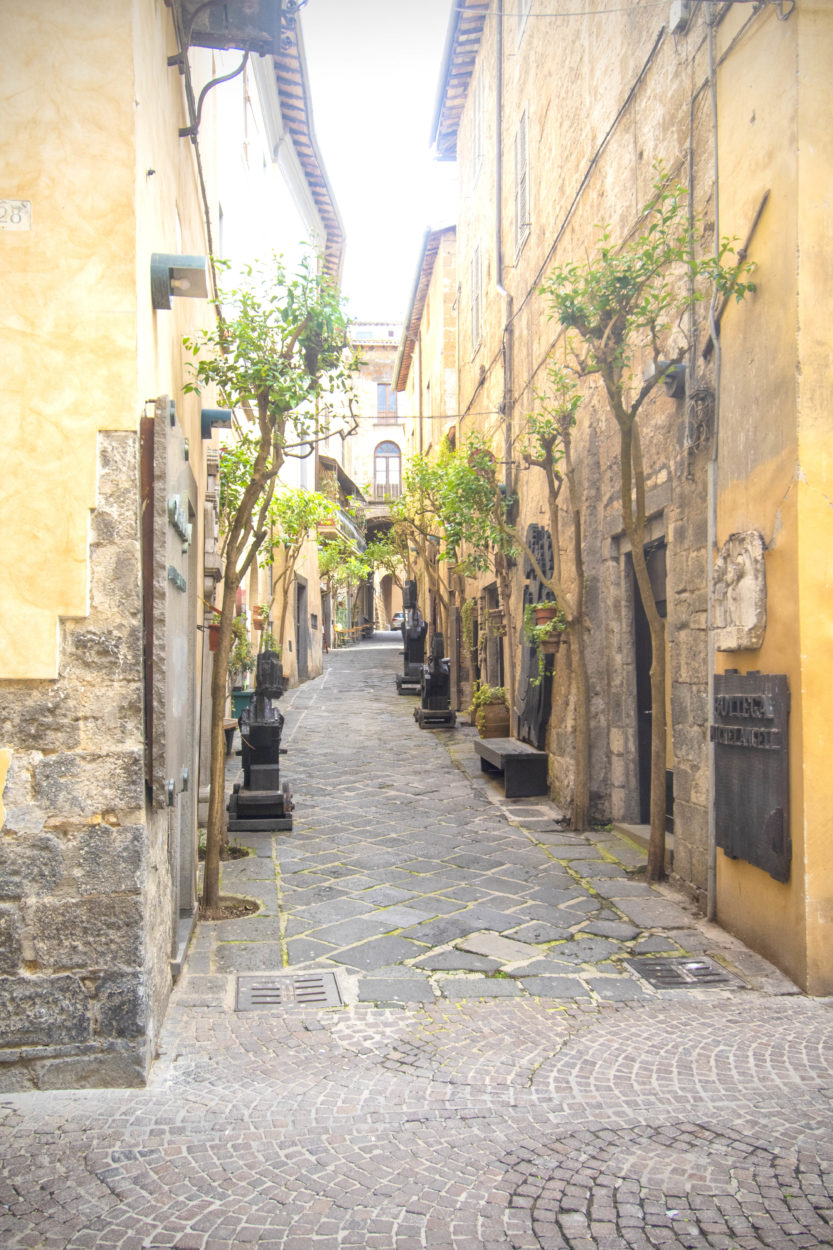
Orvieto. A side street off the main Corso Cavour.
Our visit to Orvieto was delightful on many fronts. The weather was excellent. And the relaxing of COVID-19 restrictions on movement had not existed long enough for a travel momentum to yet build. As the the photos attest, we were blessed with very light crowds of fellow lookers. Some facilities were just beginning to open.
To our delight, we found the restaurant, Il Giardino da Giovanni, to be excellent. The restaurant had been recommended by friends and we were so pleased, we returned to eat both our mid-day, main meals of the day there. We chose to return for a very delightful meal, on their outdoor, vine covered terrace that made for an exceptional 33rd Wedding Anniversary celebratory feast.
There was more to be seen in Orvieto but we deliberately chose to concentrate on just a few select sites and spend the rest of the time simply absorbing the place in a less hurried, less mass tourist impacted environment. Quiet, undisturbed enjoyment of a special place in good weather is an all too rare experience. We decided to make the most of it.
Return to Ascoli Piceno. Following a pleasant night in the hotel, with Arlene enjoying the Jacuzzi tub and followed in the morning with a very satisfying breakfast at the hotel, we departed Orvieto. Taking the same relaxed approach to returning home as we did on the outbound leg, we chose the longer, Autostrada – all the way alternative. Once again, it probably added a few kilometers on the car but avoided adding them onto me. We left Orvieto in mid-morning and walked into our apartment in Ascoli in the mid-afternoon. Glad to be home but far from exhausted.
This kind of trip reaffirms one of our goals for being here. There is ample opportunity to engage this fascinating country in smaller, concentrated doses with, hopefully, a capacity for a little more depth. At my stage of life, I am no longer attracted to endurance events.
Postscript In wanting to share experiences with friends and family it is too easy for me to let enthusiasm run away and provide far more answers than there are questions. If I have done that, please forgive the exuberance. After eight years here, we still love the experience.

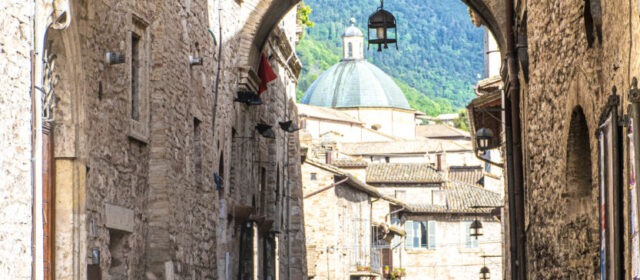
10 Comments
Ciao and Happy Anniversary! That looked and sounded like a truly memorable trip – the photos, especially the interiors, are stunning. As did some others, it almost felt like we were there; thank you. Wishing you continued health, happiness and travel for another 33 years!
Laura & Gary
Arlene and I want to say how much we appreciate each of you who have commented on our efforts, for your kind encouragement. The experiences we are having together in this special place, at this time of our lives, is something very enriching. Your sharing of those experiences with us by your support, adds to joy in being here. Thank you all.
First, congratulations on your 33rd anniversary! Secondly, thank you Larry for the very informed travel observations. I almost feel as though I went along on the trip with you and Arlene. The pictures were beautiful. Thank you both!
Fascinating and beautiful, as always. Very many thanks, yet again, for providing us with these wonderful vicarious experiences.
Thanks for the history lesson absolutely loved it. Baci
You can imagine how much I enjoyed this blog considering our upcoming trip to Italy! I hope it will be the beginning of many. Cannot wait to spend time with the two of you.
Larry as always you write beautifully and captured the spirit and beauty of Assisi and Orvieto and your photographs enhance that . Keep on travelling !
Larry…Truly enjoyed your anniversary travelogue to Assisi and Orvieto..and the beautiful photos of ancient buildings and landscapes. It took me back to a trip I took with Palomar College Art Department. That was my first exposure to Italy and Italian art…and I fell in love with it all. Thanks for rekindling those memories!
Excellent travelogue. My question is what parts of Etruscan carving were incorporated.
Hello,
Thanks for taking me back to my trips to Assisi and Orvieto! In the St Francis basilica lower part, there is a triptych painting that is referred to as “the Hitchhiking Madonna”.
A lady from Santa Barbara bought 2 properties in Orvieto, and one she rents out as a BnB. The view of Orvieto as you drive out of it with the sun setting on it is absolutely gorgeous. It is an amazing cathedral; I spent just as much time sitting outside across from it looking at it as I did inside!
Nice that you were able to see it with few tourists–that is a positive aspect to the virus, if one has to find one.
I’m hoping to get to Italy in the fall…right now I am enjoying a live virtual walks through Italian towns. I have to be satisfied with that until I can get there! I have friends who also bought an apartment in Chianti, and then the pandemic hit. They are planning to get there for the first time in September! in the meantime, they are able to have it rented out a little bit.
I so enjoy your writing….